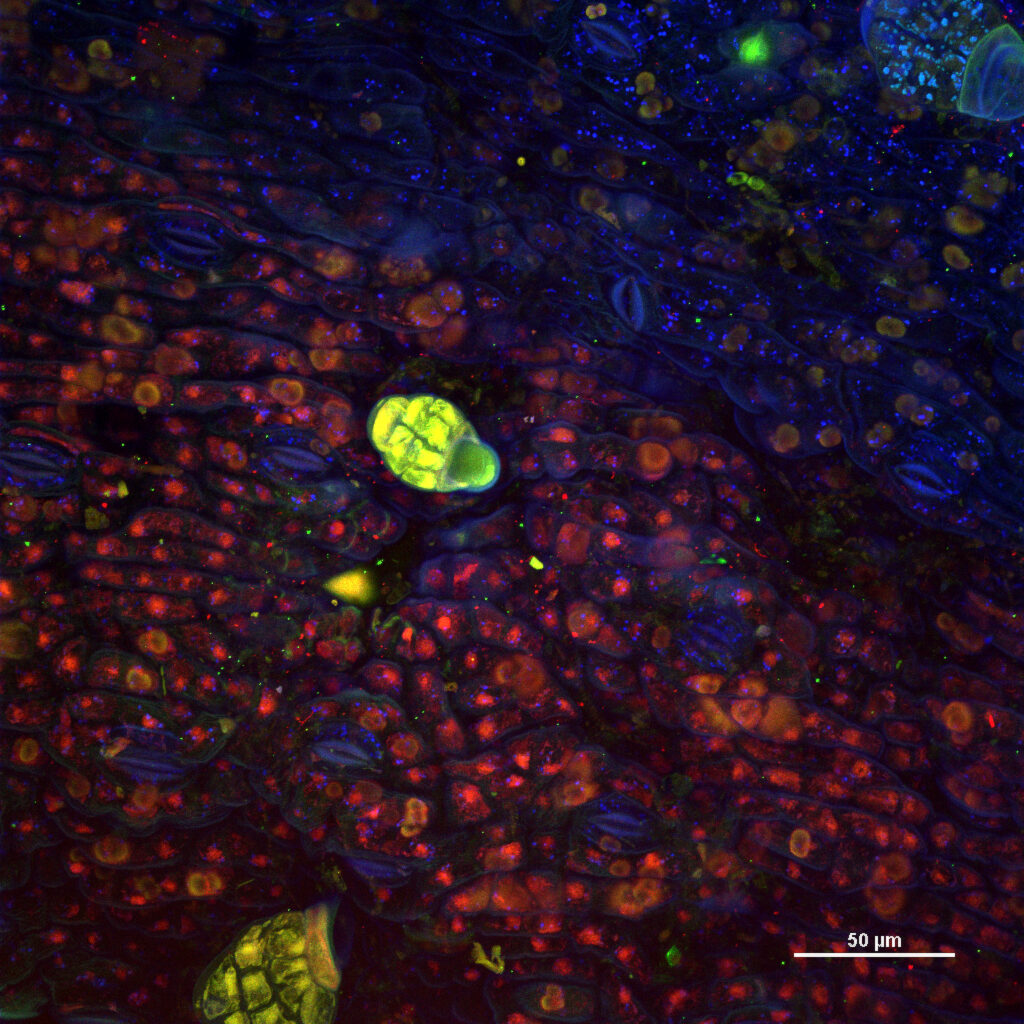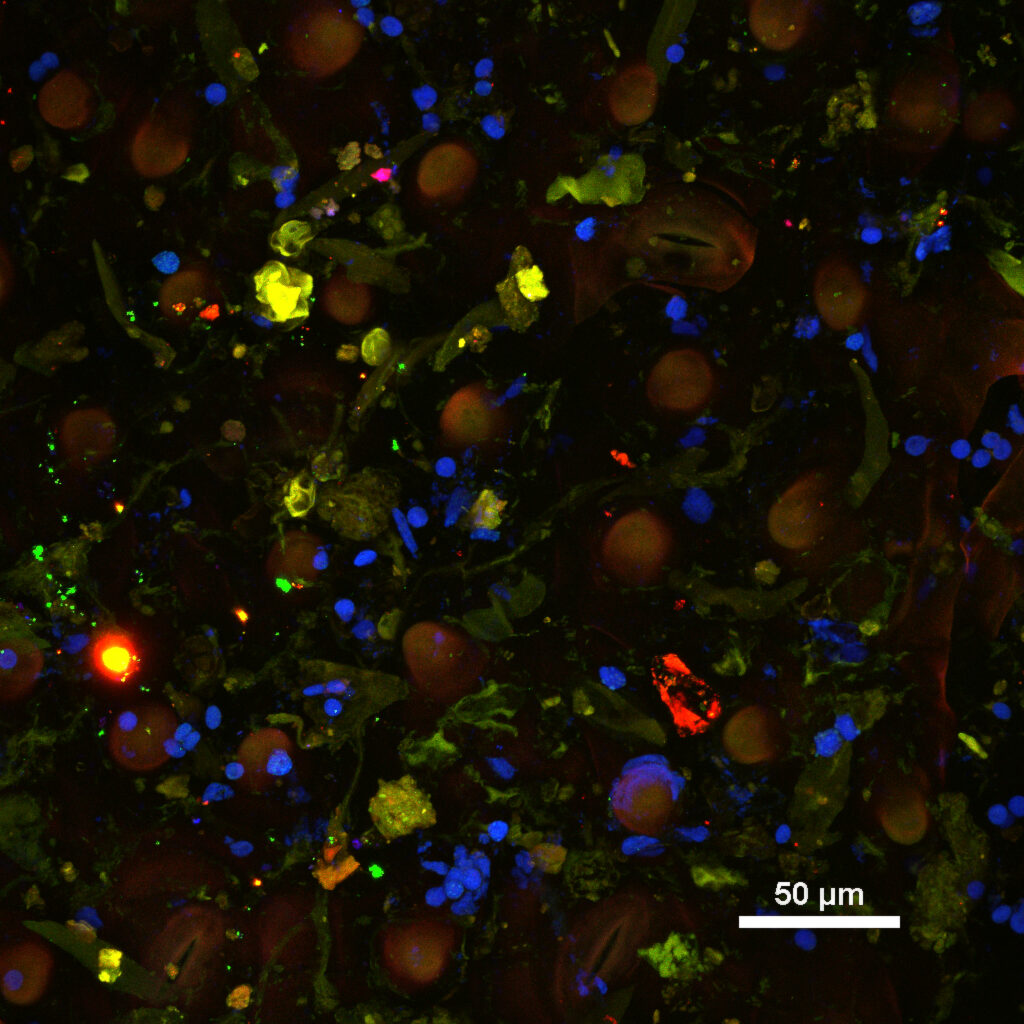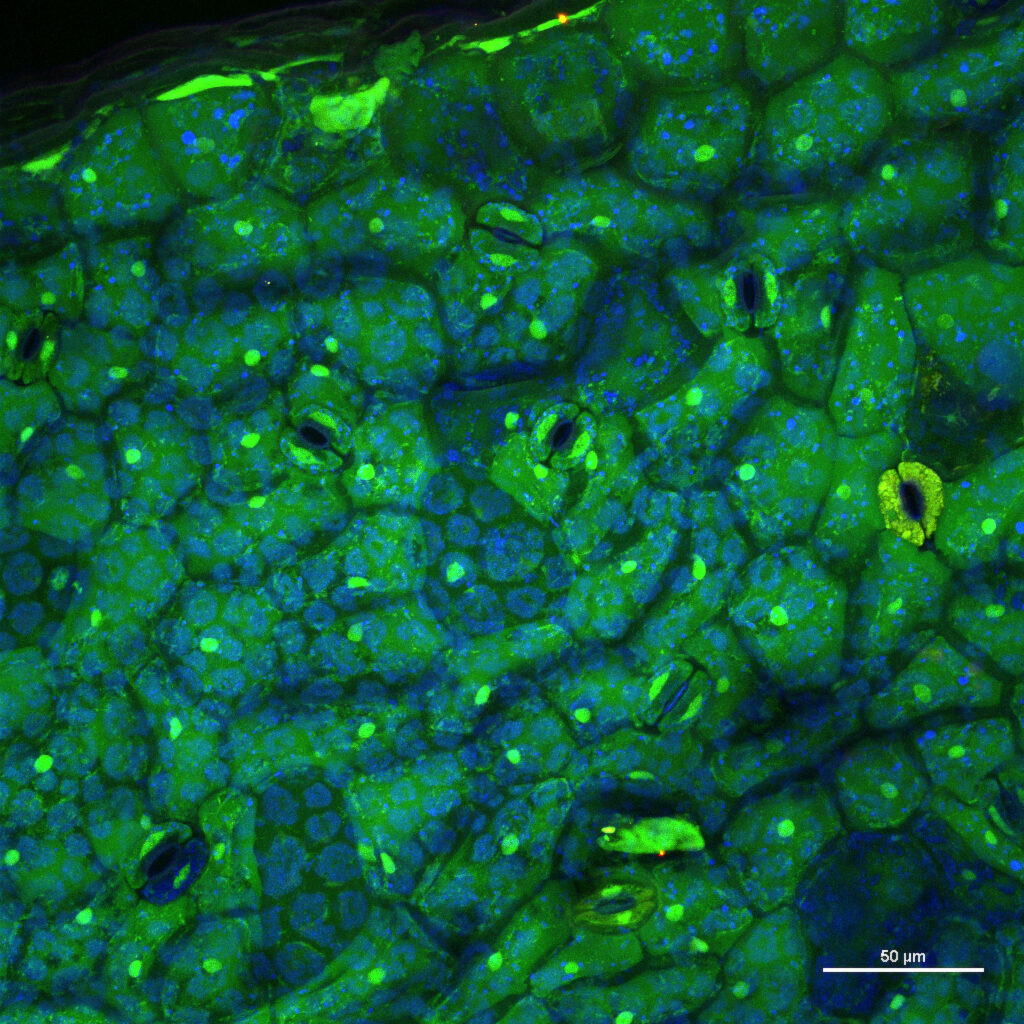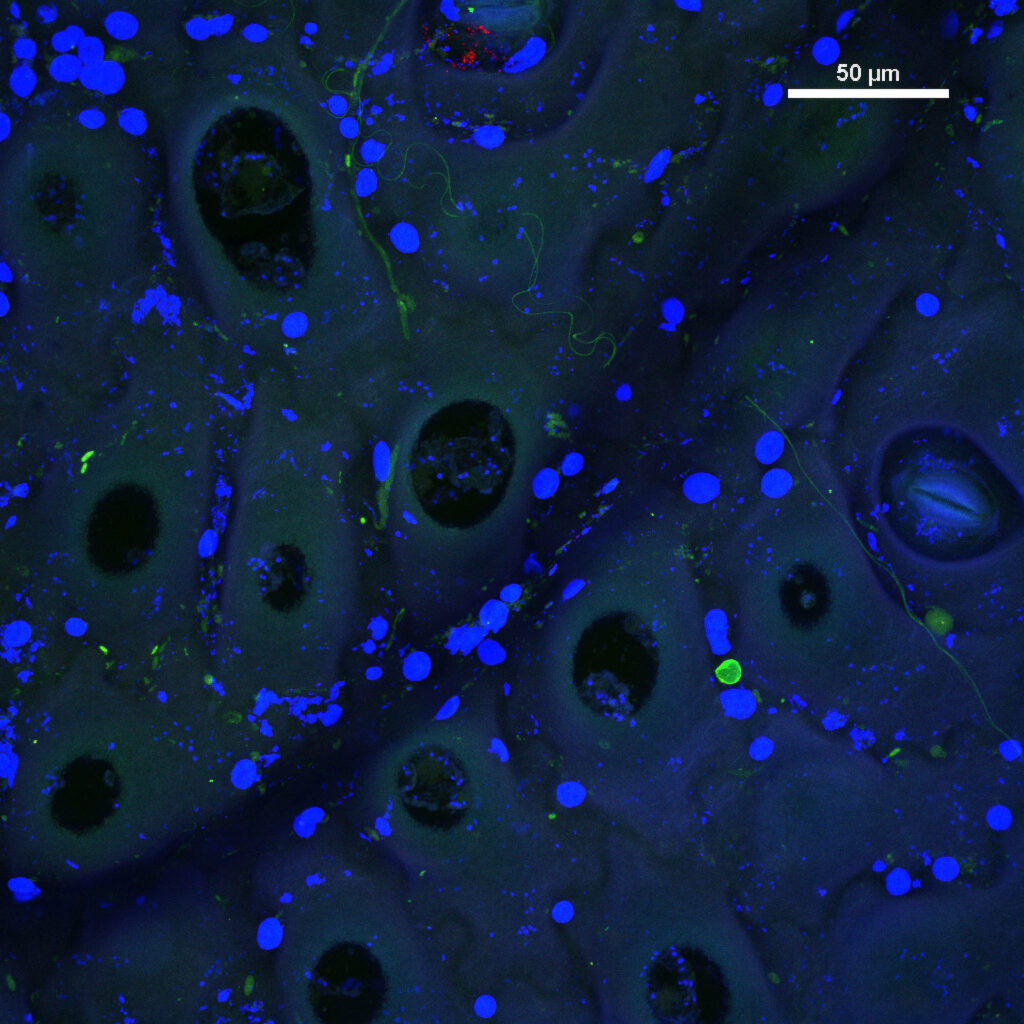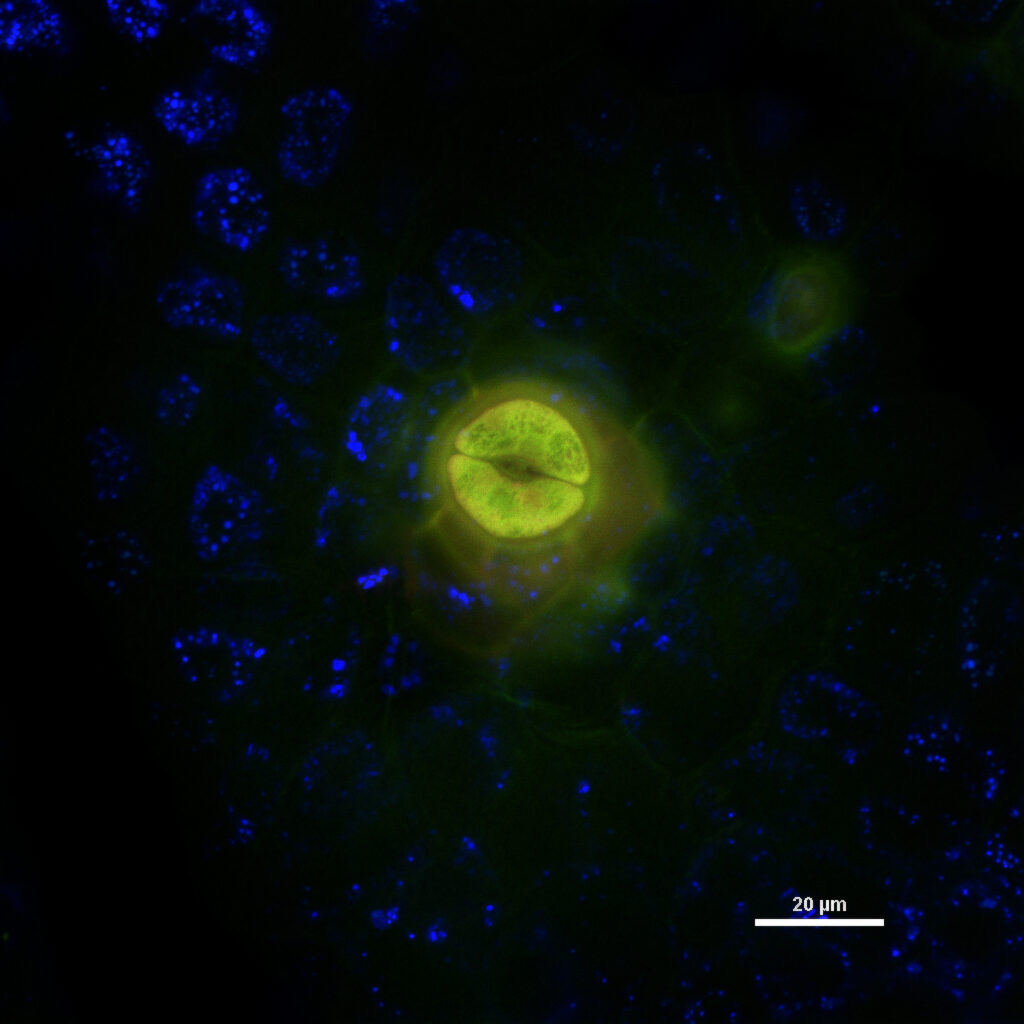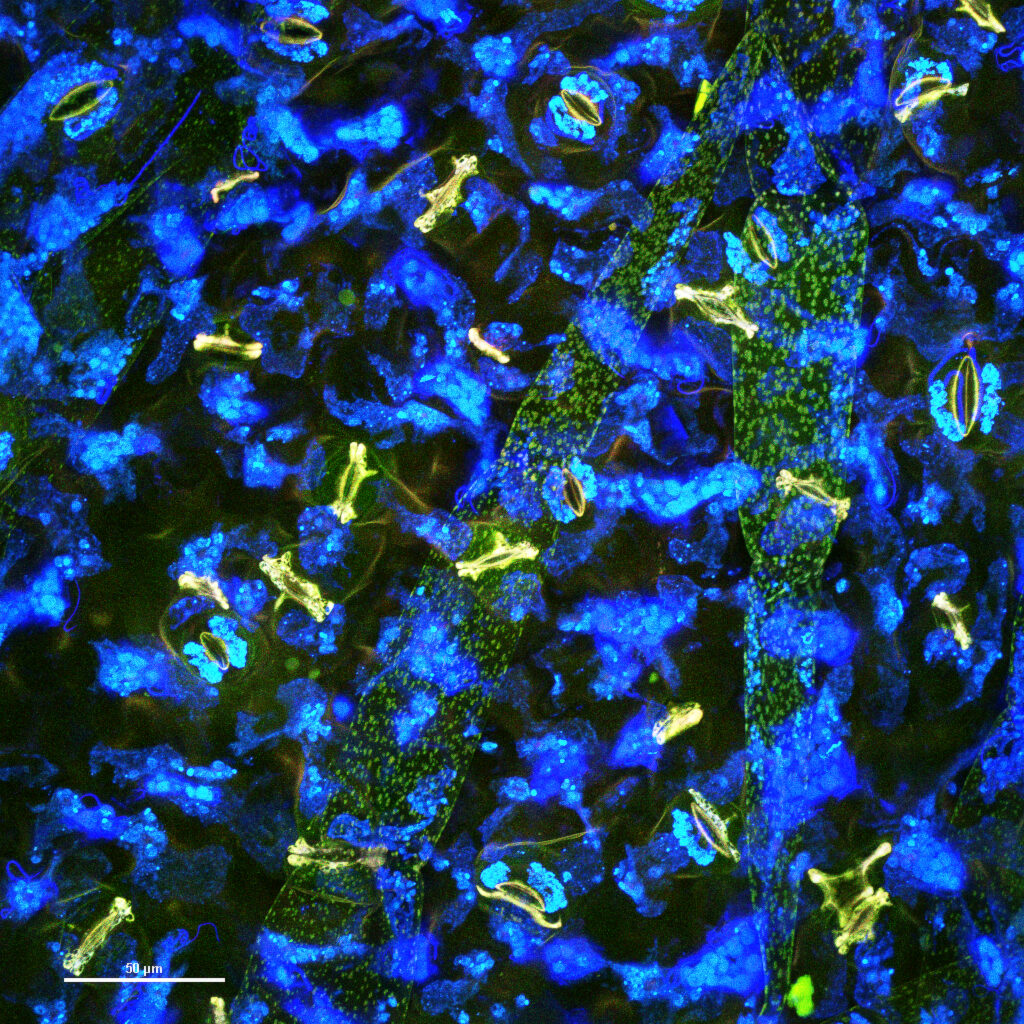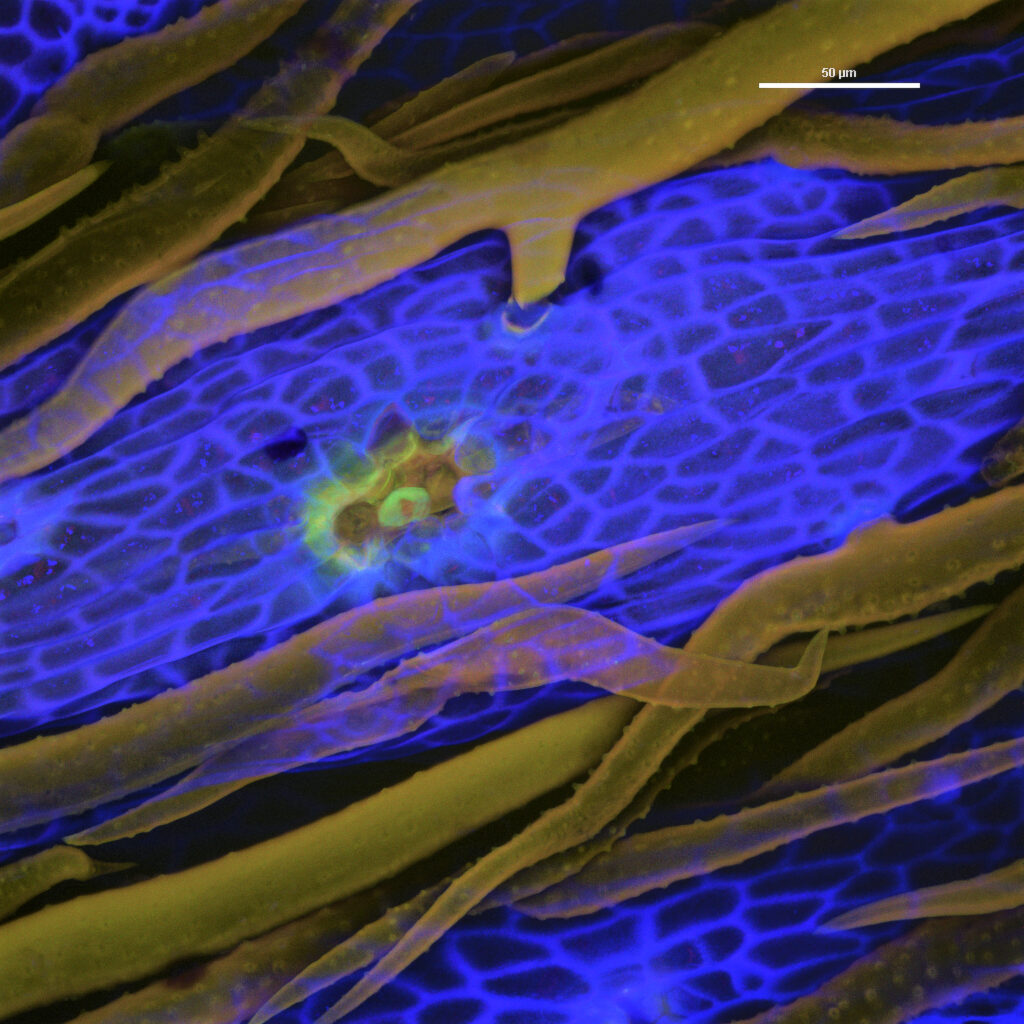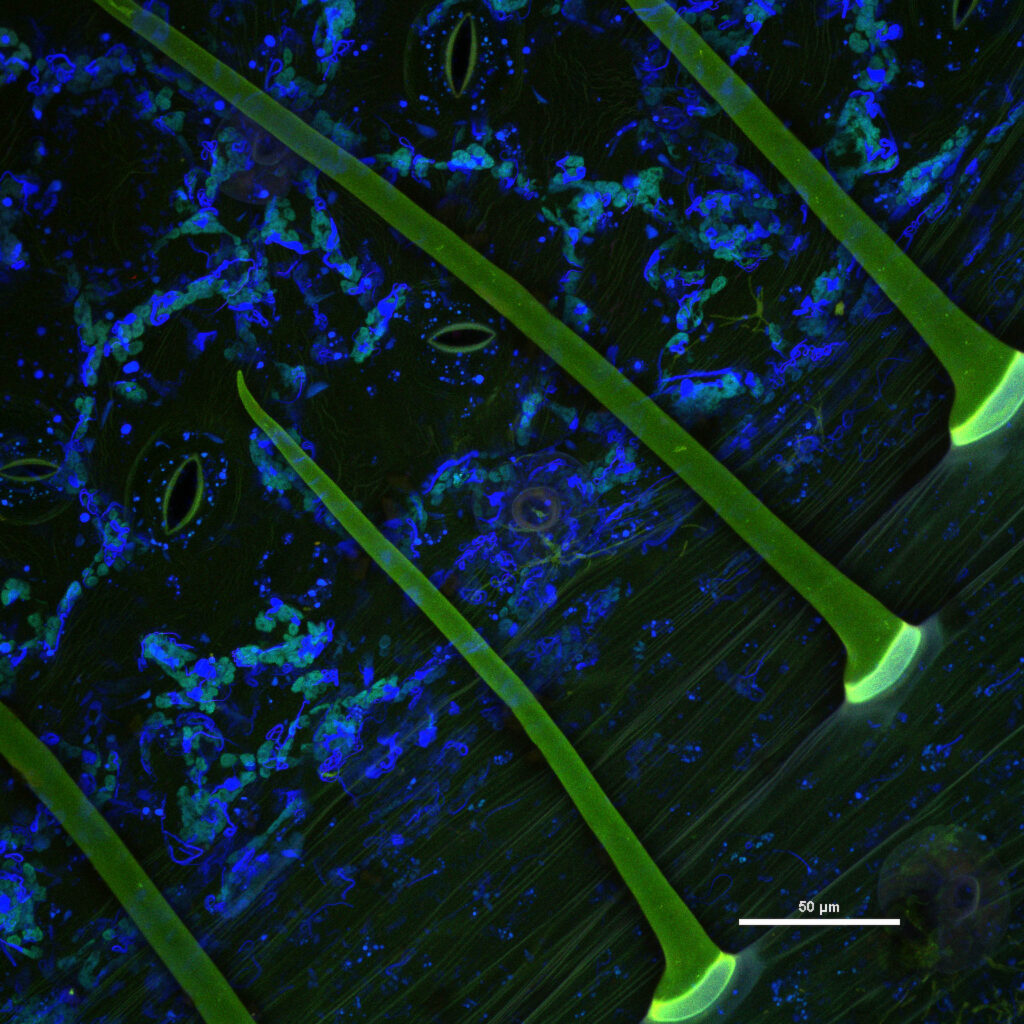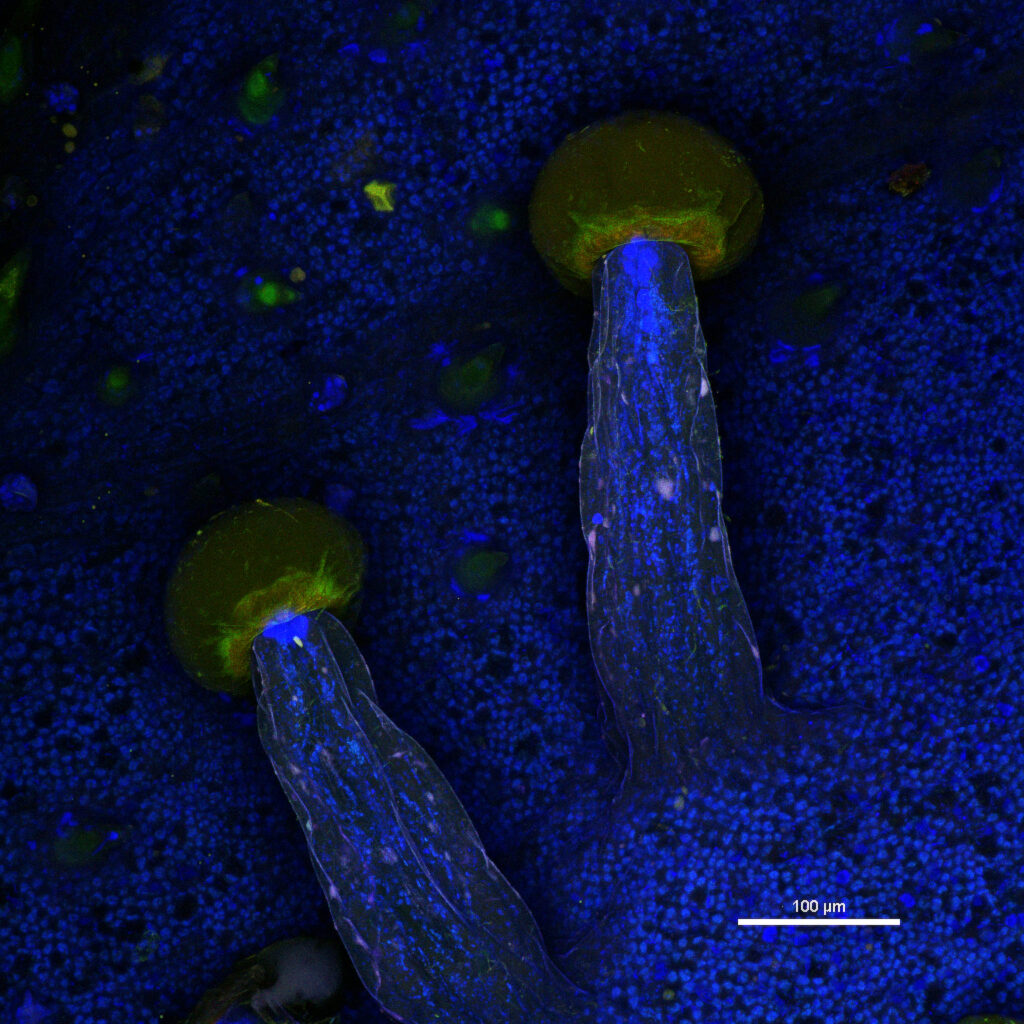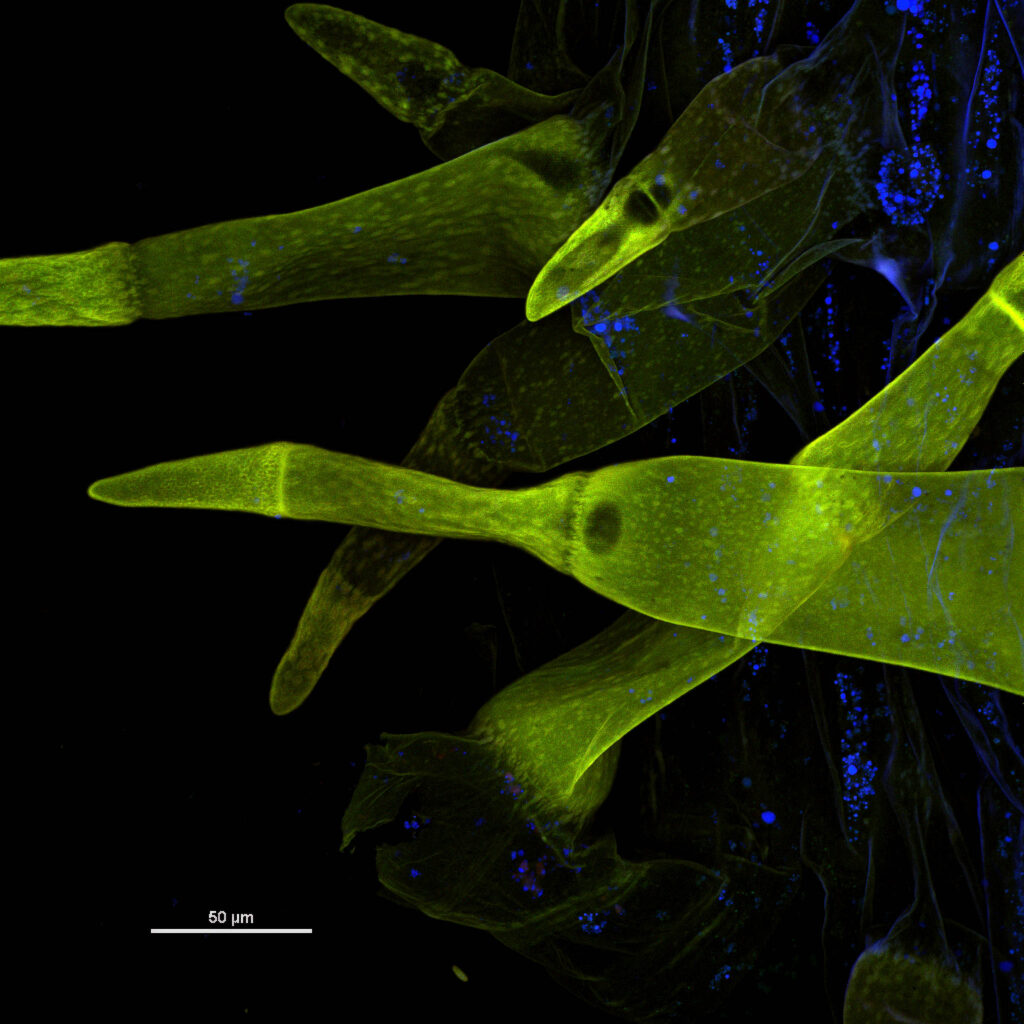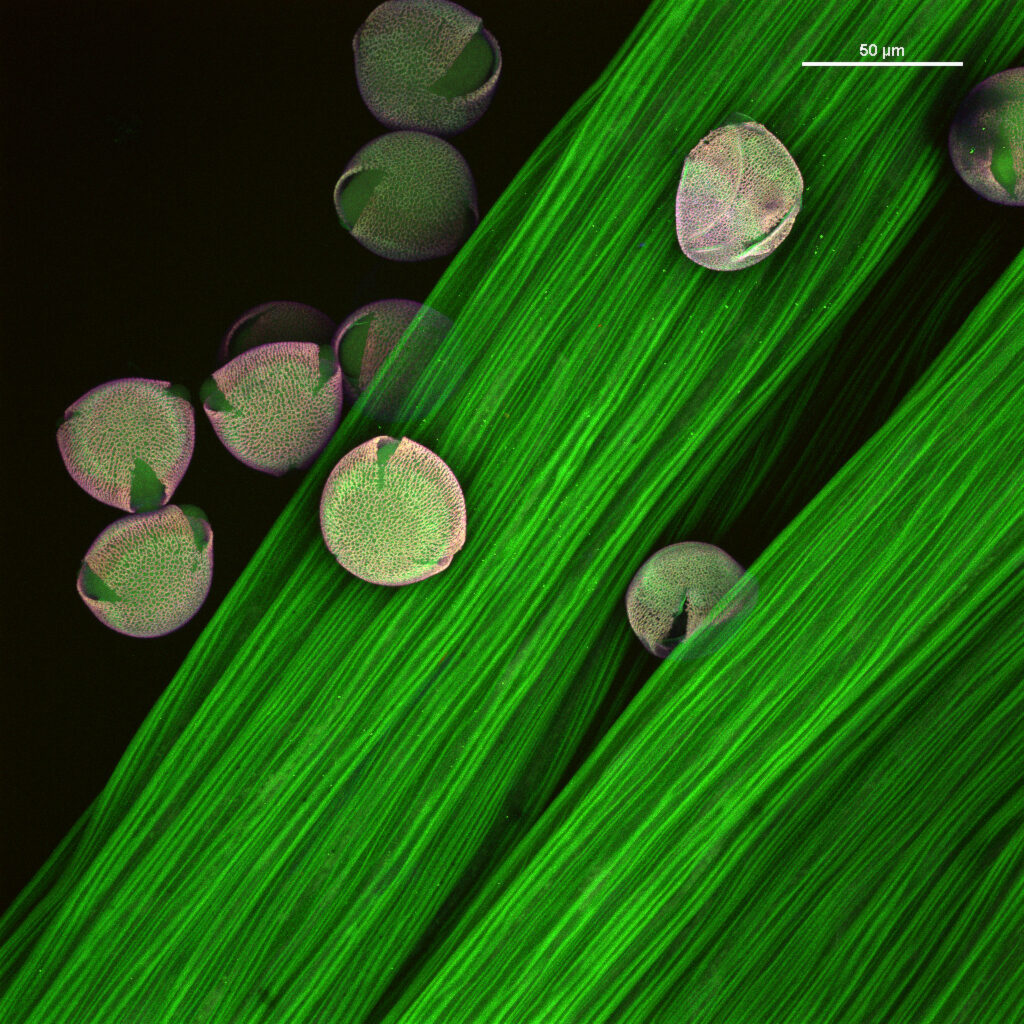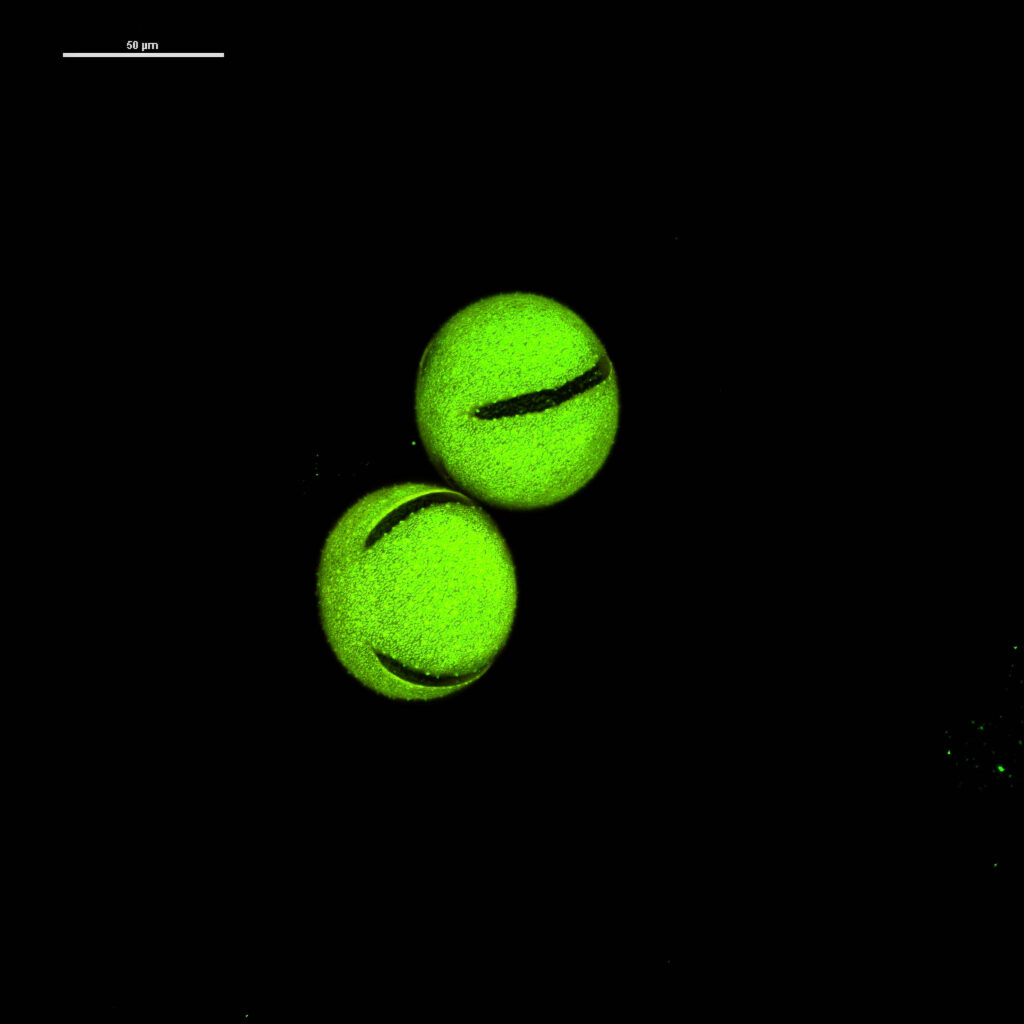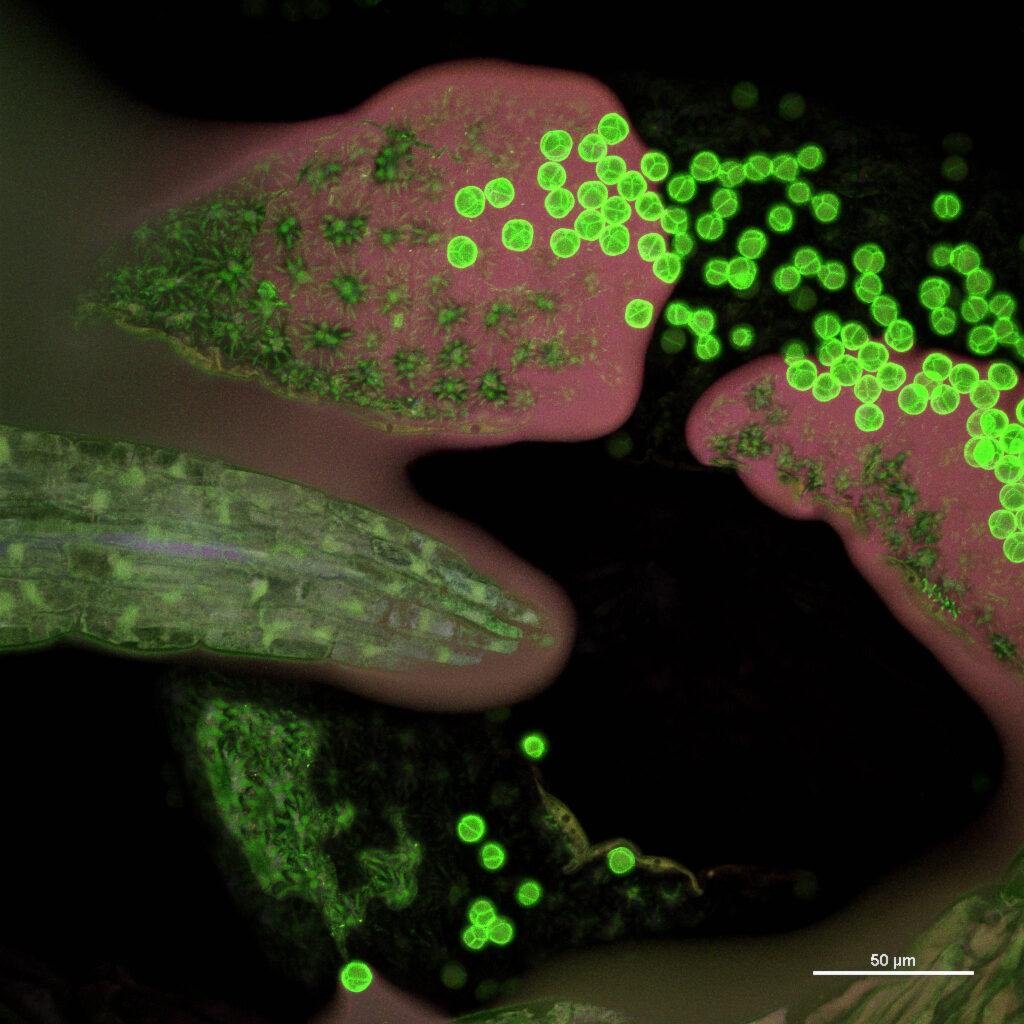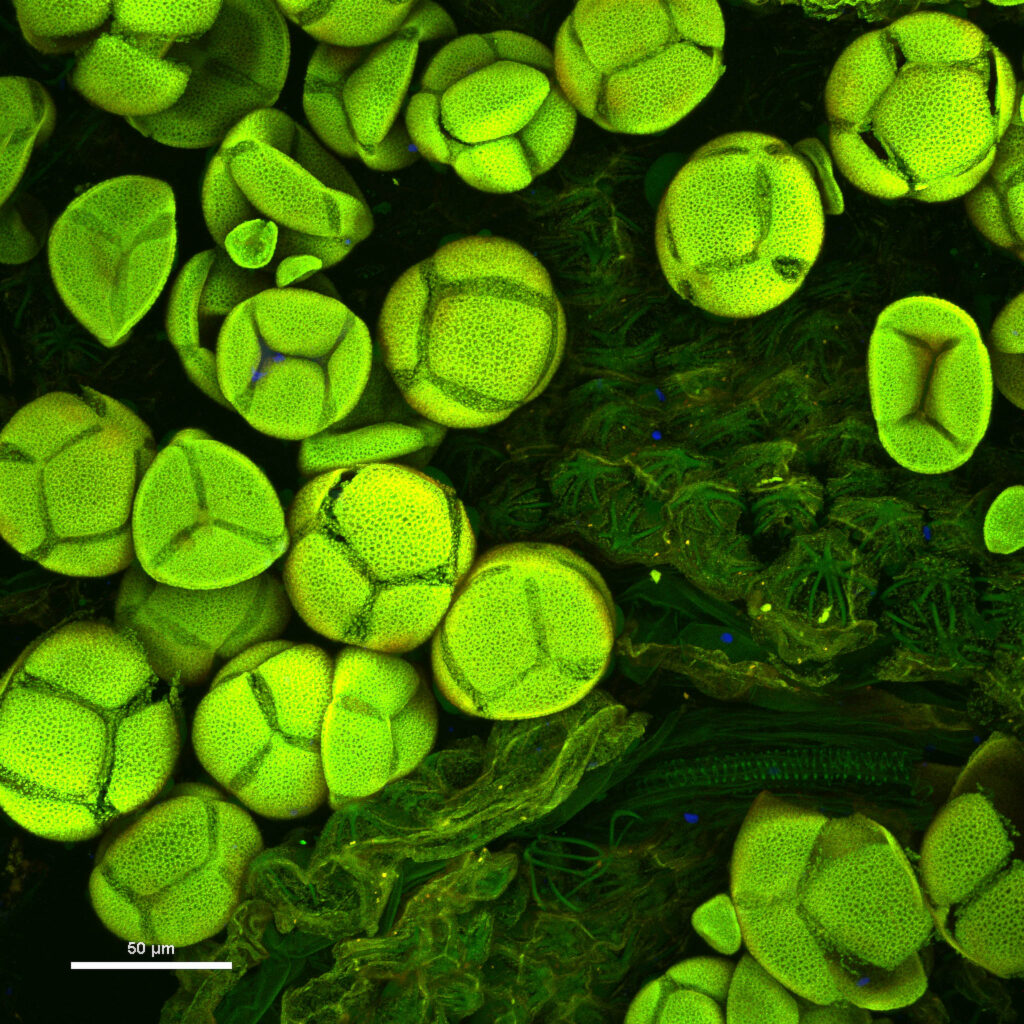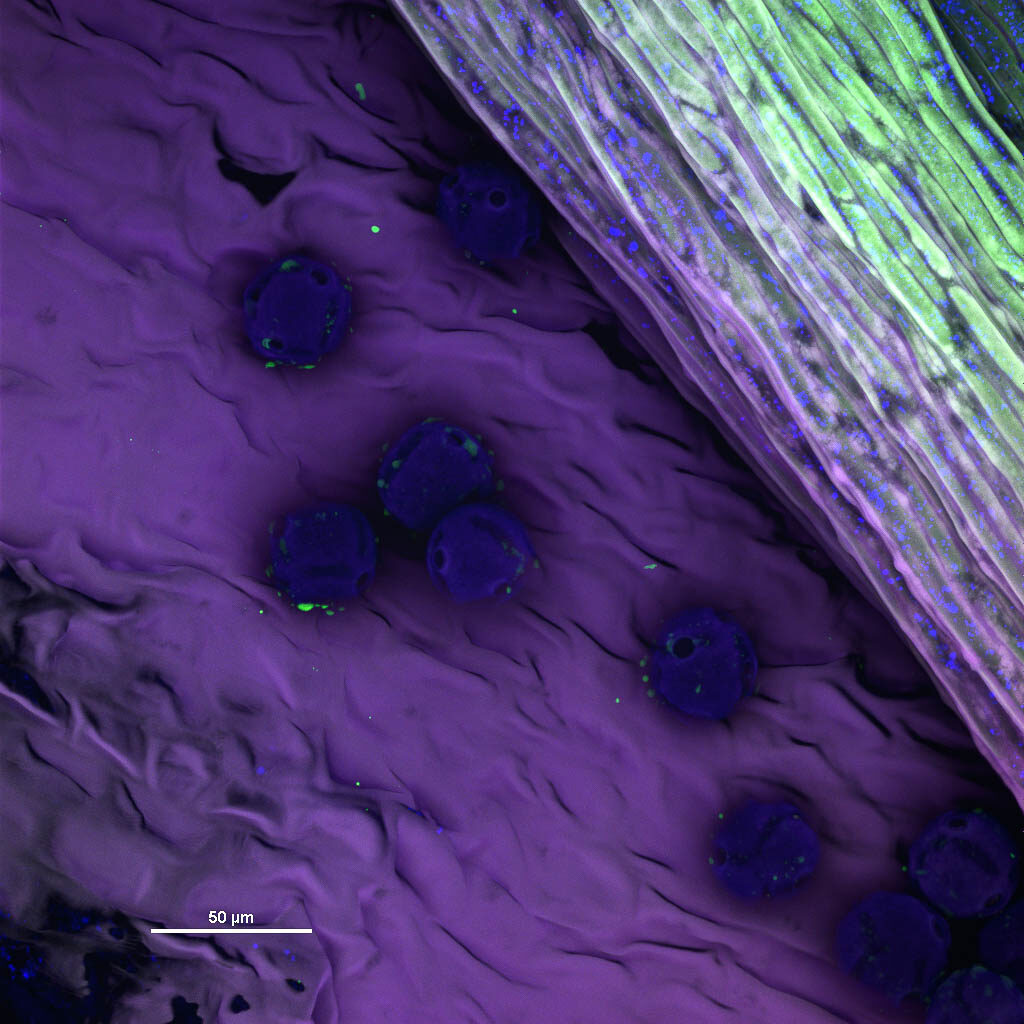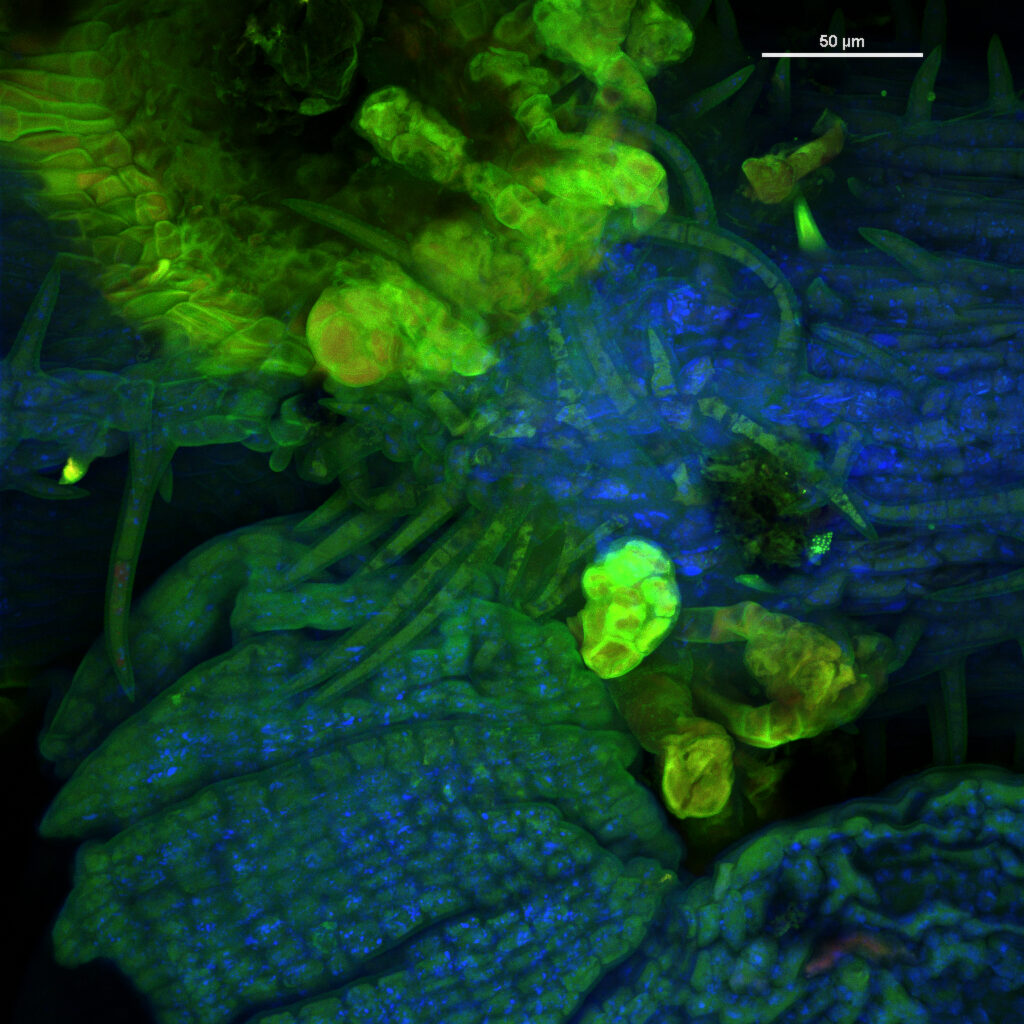Microcosmic Phytoformalism
Plant-Art, Visionary Experience and Eco-Activism
–Steven F. White
In “The Miniature,” Susan Stewart believes that “the microscope opens up significance to the point at which all the material world shelters a microcosm.” She also affirms “that the world of things can open itself to reveal a secret life—indeed, to reveal a set of actions and hence a narrativity and history outside the given field of perception.” For Stewart, “this is the daydream of the microscope: the daydream of life inside life, of significance multiplied infinitely within significance.”[1] It is precisely in this multiple sense that I would like to begin to define Microcosmic Phytoformalism as a critical framework, a lens through which images produced by the confocal microscope can be analyzed. The plants in this unique gathering each reveal their particular microcosms, their secret stories as a species, their meaningful vegetal lives within lives. And perhaps we can be inspired to learn to become with them. The magnified plants—with their stomata, trichomes, vascular tissue, xylem and pollen—create new definitions of art derived from living biological material: a leaf, a stem and, sometimes, a flower. This microcosmic world is also an invitation to explore the visionary realms that these plants (held sacred in spiritual accords by Amerindian groups spanning the continent) can open to those who use them with respect. Like much contemporary art, these visions are not always pretty. Indeed, the plants often reveal the grotesquely destructive human behavior that has threatened biodiversity on a planetary scale, including, of course, our own species, accusing us in no uncertain terms as being responsible for this ecocide. These vivid experiences are extremely difficult to assimilate in their magnitude and are accompanied by feelings of outrage and despair. The plants are heroic emissaries from a moribund world, and, as Terence McKenna puts it, inter-species chemical messengers that serve to transfer information from one species to another. Seeing is believing. And the confocal images of the sacred plants in combination with the psychoactive properties many of them possess and have shared with humanity can be effective tools for truly critical perception, as well as for new phytocentric collective visions of eco-activism and militancy.
The Olympus Microscopy Resource Center website, with information from late 2012, includes a brief history of the confocal microscope that begins with Marvin Minsky, a Harvard University graduate student who patented the basic concept of confocal microscopy in 1957. Decades would pass, however, before the technology necessary to do the work that can be appreciated in the confocal images of these plants collected in Microcosms would come into existence. To be more precise, according to the authors from Florida State University, the knowledge crucial for this method of seeing was perfected as recently as a decade ago in 2010 (though Jill Pflugheber disagrees with the lateness of this date): “Modern confocal microscopes can be considered as completely integrated electronic systems where the optical microscope plays a central role in a configuration that consists of one or more electronic detectors, a computer (for image display, processing, output, and storage), and several laser systems combined with wavelength selection devices and a beam scanning assembly. In most cases, integration between the various components is so thorough that the entire confocal microscope is often collectively referred to as a digital or video imaging system capable of producing electronic images. These microscopes are now being employed for routine investigations on molecules, cells, and living tissues that were not possible just a few years ago.”[2] No doubt, this technology will continue to evolve, rendering our current cutting-edge tools for perception obsolete. Even so, from our perspective now, these confocal images are filled with stunning revelations of hidden beauty.
Each epoch seeks an opportunity to perceive the world in innovative ways, in keeping with existing biotechnological capacity. A hundred years ago, for example, the German scientist R. H. Francé wrote about the reactions of his students when they used the newly-improved microscopes of their time to observe algae. There were, he says, “exclamations of rapture.” Everything they observed was “astonishing and startlingly new.”[3] With these confocal images of sacred plants from the Americas, one hopes that it will be possible to recapture that earlier rapture! But then what? The next step entails discovering how this enthusiasm and energy can be channeled into making ecocide an international crime, creating Rights of Nature laws embedded in national Constitutions and, concomitantly, decriminalizing the so-called natural psychedelics (ayahuasca, peyote and sacred mushrooms, for example) currently subject to repressive laws that are nothing more and nothing less than a cruel and ignorant extension of the culture of prohibition of the Spanish Conquest of the Americas, the foremost initial objective of which was to ban sacred plants and the indigenous rituals and religious ceremonies accompanying them that were the basis of pre-Columbian social cohesion. Traditional healers themselves were subject to torture, enslavement and death at the hands of the conquistadors. The ancestral knowledge gained from plant-teachers remains under threat centuries later, though there has been a remarkable resurgence of respect for these traditions that have persisted in a subterranean way all this time and are being preserved and disseminated by new generations seeing their elders succumb to the pandemic, through publications in indigenous languages[4] and through social media on the Internet.
Clearly, electronic technology has become the basis through which a shared interdisciplinary platform has been able to develop. And the Microcosms project incorporating confocal microscopy is at the exciting confluence of art and science. In “A Proposal for Softening the Boundaries of Science” from Common Denominators in Art and Science, José Reissig seeks ways to integrate more fully these two distinct cultures. Scientists, he believes, open borders with technology, but have a tendency to remain closed conceptually, “as science cultivates the myth of historical and philosophical self-sufficiency.”[5] Whereas science operates with what Reissig characterizes as a tightened border surveillance accomplished by specialized language in academic publications, the art world, on the other hand, has comparatively softer frontiers. Reissig proposes importing into science some of the transgressive techniques and language of the art world. He speaks of the need for fomenting empathy for creative thinking in both art and science and wonders how scientists might collaborate to offer works “as being worthy of aesthetic contemplation.”[6] There are examples of this, and they can be found readily in the breathtaking results of the annual Nikon Small World Photomicrography Competition.[7] I firmly believe that this website, Microcosms: Sacred Plants of the Americas, is also demonstrable proof as to how fruitful this transdisciplinary dialogue can be. Why? Because these aesthetically-captivating digital images encourage discussion of ecological concerns and unique, often threatened, interrelated systems studied by biologists as well as artists inspired by the processes and forms of the physical world. Microcosmic Phytoformalism is, then, by definition, an important element of environmental art, which, for Emily Brady, enables “diverse forms of aesthetic-moral interaction with natural environments, objects, processes and creatures.”[8]
Botanical Structures as Sites of Contemplation
Microcosmic Phytoformalism is, in addition, theory that inevitably leads to practice. It invites the contemplation of certain formal botanical structures, confined here for the sake of expediency to stomata, dermal tissue, trichomes, xylem and pollen. These bioforms are clearly visible in the confocal plant-art images constituted by sacred plants that grow in the most diverse American landscapes imaginable, from deserts to rain forests. To analyze this material, one needs to take into account without fail the biologically-complex habitats of these plants, how these interconnected ecosystems are threatened and what needs to be done immediately to protect them. Charissa N. Terranova and Meredith Tromble, coeditors of the Routledge Companion to Biology in Art and Architecture, delineate the ecological objectives that underlie their publication: “We also seek to address contemporary political problems generated by scientific realities. The degradation of the environment is most obvious. It calls for a stronger basic understanding and greater consciousness of biology across all species within the humanities and science as well as in everyday life […] Our goal is to show that art-and-science endeavors are not bound to any one way of being: they are indicative neither of the violent takedown of a reified and mystified science nor of a passive instrumentalized relationship in which art is the servant of science. We are interested in modes of analysis that are generative: engaged with biological metaphors and information as a means to support the future flourishing of life.”[9] I especially appreciate the idea of the confocal images as generative, a means to propitiate and potentiate vitality in a literal as well as figurative sense.
A key underlying term here is the “epigenetic landscape,” which is defined by Terranova as “an actual scientific theory on evolution, environment and ecology which connects artistic representation to the philosophies of theoretical biology.”[10] This “organismic” approach to creativity, says Terranova, incorporates the “use of living, biological materials in artistic practices.”[11] In terms of applying Microcosmic Phytoformalism as a critical tool for understanding specific confocal images, I would suggest that a limited number of rudimentary elements of plant systematics be considered sites of contemplation. Stomata, for example, open and close pores on the surface of leaves and stems to allow plants to take in carbon dioxide and release oxygen as a byproduct of photosynthesis. The apertures are surrounded by bean-shaped parenchymatic cells (guard cells), which, through astonishingly complex signaling networks, control the size of the openings in order to regulate the gaseous exchange and control transpiration. Environmental stimuli that influence this process include relative humidity, carbon dioxide concentration, light intensity and temperature. Stomata should not be considered passive portals of entry to the plant since current research has demonstrated stomata-based defenses against destructive bacteria. Elsewhere in the website, I highlight the abundantly-visible stomata of Brunfelsia and wonder if it would be possible for viewers to imagine breathing with this art in its living form. Almost every species we were able to include in Microcosms offers its stomata. So, why not try some co-becoming with the plants by means of co-breathing and be on a first name symbiotic basis with Ceiba, Peyote, Copal, Chaliponga, Chacruna, San Pedro (Huachuma), Tobacco (Sayri), Culebra (whose stoma in our collection surrounded by yellow guard cells resembles the eye of a snake), and many others. Perhaps it could mean being more conscious of the immediacy of plants in your personal life. Additionally, as a site of microcosmic aesthetic contemplation, the stomata of these varied species could also reveal a different layer of time, since fossil plants with relatively fewer stomata indicate higher carbon dioxide levels and, therefore, plants that lived in times of high global temperatures. When some future living thing traverses the fossils of plants from our Anthropocene epoch, where will we be as a species? Extinct?
How is it that an exquisite stained-glass beauty of compartmentalized colors in the dermal tissue of Psychotria viridis and Diplopterys cabrerana characterizes these two plants that are the DMT source in the sacred beverage ayahuasca/yagé? Perhaps the images themselves could be conceived as visual alkaloids, the equivalent of the stimulant defined by Jonathan Ott as “nitrogen-containing organic compounds which represent the pharmacologically-active principles of many plants”[12] including a majority of those that are gathered in this website. Why couldn’t these confocal images be contemplated as a pathway to promoting altered states of consciousness? The exquisite repeating patterns in endless variety of the dermal tissue also include pavement cells that create a jigsaw puzzle of living and changing pieces, as is the case with Anadenanthera colubrina and Desfontainea spinosa. If each species were to be considered an artist of itself, the dermal patterns of the “self-portraits” might be viewed in light of J. P. Hodin’s idea of “the painter’s handwriting”: écriture, style, touche. These images are examples of the handwriting of plants, a manifestation of their personality, a clue to their traditional affiliations, inimitable in its subtlety, the touch not only of cycles of growth in an individual plant but also of evolution. Underlying this distinctive style are the elements of great works of art: structure, weight, density, motion. Écriture is not simply technique, since technical procedure, in Hodin’s words, is not “the way in which form is brought to life in the material.”[13] It is something else, difficult to describe, like Art itself in its varied forms.
The trichomes (from its Greek etymological origin meaning “hair”), too, are so utterly distinctive, as in the case of the other plant used in the preparation of ayahuasca: Banisteriopsis caapi. When I first saw the way these T-shaped trichomes are attached, understanding that this is a trait of the Malpighiaceae family, I was reminded of the tail of a whale, after it has breached and dives again into unimaginable depths. And you, watching your screen while holding a bar of your favorite chocolate–the sublime five-fingered stellate non-glandular trichome of Theobroma cacao surely will transform your next bite. One of the primary functions of trichomes is to provide the plant physical and chemical protection from microbes and insects. We had other images of Turbina corymbosa (Ololiuhqui), but only the one we include here possesses such dramatic activated sentinels guarding precious and strategic inner worlds. The image of Paullinia cupana (Guaraná) is destined to appear in colossal form in a science fiction movie as it hovers over the White House ready to obliterate it with unstoppable glowing tentacular weapons. Cannabis seems like a remarkably enigmatic and charismatic storyteller with its shining, hair-like cystolithic trichomes in addition to the mushroom-like capitate stalked glandular trichomes. We could have placed these scientific names with an arrow in the image for the purpose of proper identification. Would one wish do this with particular aspects of human anatomy in magnified versions of Renoir’s paintings or Mapplethorpe’s photographs? Could one do this at all with Cubist Picasso? “But what are you and Jill actually looking for?” asked my well-meaning, though skeptical, colleague from the Biology Department. There will be, I sincerely hope, many ways of regarding and appreciating these confocal images. The possibilities for what can be sought may go well beyond our individual disciplines and even the images, taking us back to the living plants themselves and the stories they can tell.
A fourth basic plant-form worthy of contemplation is xylem. Xylem vessels are vascular bundles in plants that serve to transport water and minerals with a unidirectional flow from roots to leaves. Located at the center of the plant, they are composed primarily of dead cells to facilitate greater capacity to carry water. With walls reinforced with lignin, xylem vessels have two primary forms, both of which are aesthetically inspiring and can be found in these confocal images. Strangely enough, the coiled xylem is particularly impressive in the formidable Brugmansia known as “Culebra” (Snake). In annular vessels, the lignin forms a pattern of equidistant circular rings. With regard to spiral vessels, the lignin resembles a helix or coil. One need not be a botanical expert to begin to appreciate the dynamic vitality and beauty of these forms that enable systems requiring cohesion and adhesion to function. The confocal images with their stunning depictions of xylem understood from the perspective of Microcosmic Phytoformalism instill appreciation of the flow of water that ensures the survival of all living things.
The marvels of fundamental observable phytoformalism would not be complete without pollen, which delivers males gametes to an ovule of a compatible flower to fertilize an egg that then becomes a seed. It was not always possible for us to image pollen and its astonishing variable beauty, but we were very impressed with the results when we did get the chance to work with flowers from the sacred plants. Pollen grains from Angiosperms range in size from 25-250 microns in diameter. The pollen grains in Microcosms are 50 microns or smaller. In his “Foreword” to Pollen: The Hidden Sexuality of Flowers, Professor Sir Peter Crane points out an important aspect of the Royal Botanical Gardens, Kew: “The centre of gravity of botanical art has always been the accurate representation of whole plants and flowers, which in turn has been inextricably linked to the scientific objectives of documenting plant diversity. However, in the context of Kew’s broader scientific mission, there has always been a parallel strand of art that has focused on the microscopic structure of plants. Ever since the early work of Nehemiah Grew [1641-1712] and others, both artists and scientists have been fascinated by the intricate structures revealed by microscopes.”[14] In fact, it was Grew who is believed to be the first person to describe pollen in his 1682 work The Anatomy of Plants (With an Idea of a Philosophical History of Plants).
Even an expert such as Prof. Anna Dobritsa from the Department of Molecular Genetics at the Ohio State University, co-author of complex and fascinating studies on the magnificent patterns on the pollen surface, says in her publications that such and such “is still poorly understood,” or this “remains unknown,” or, with regard to certain processes, “there are many unsolved mysteries and puzzles.” For us, then, we may need to be content with pollen, a quintessential component of Microcosmic Phytoformalism, as a perplexing aesthetic source of both inspiration and wonder.
In the introductory section of their study of pollen micropatterns, Dobritsa and her research partner Rui Wang affirm: “Pollen grains of seed-producing plants act as specialized vehicles delivering immotile sperm cells to female structures. Pollen, therefore, plays a key role in plant reproduction—and it performs this role in style.”[15] This style is our precise concern. What the two scientists maintain should make us pay especially close attention as we contemplate the confocal images of the pollen from plants included in the Microcosms website: “Pollen patterns can differ tremendously in their appearance, making the pollen surface one of the most diverse microstructures in nature.”[16] Exactly. And the confocal microscope can begin to reveal a small part of this morphological diversity. If it is a gigantic pollen party with thousands of images that you seek, I invite you to give yourself over to this site organized by specialists from the University of Austria, Vienna: https://www.paldat.org/ It is also possible to get open access (from Springer) to the Mother of all Pollen Books organized by the same folks in Vienna: Illustrated Pollen Terminology by Heidemarie Halbritter et al. The book will stimulate you to admire the ingenious, infinite artistic beauty of this particular plant-form or give you a terrible headache at no extra cost. I had both experiences! However, I was pleased to learn that the proper term for the pollen of Banisteria muricata is “pantocolporate”. Will I remember this when I drink an infusion made from its dried flowers?
The outer wall of the pollen grain, called the exine, usually has ornately sculptured three-dimensional designs that are species-specific and is composed of a highly-resistant biopolymer. How tough is it? As Dobritsa and Wang write: “The extraordinary stability of sporopollenin accounts for exine preservation for hundreds of millions of years in fossil material and allows paleontologists to address questions related to past states of climates and vegetation and determine evolutionary relationships between plants.”[17] The geologic history of terrestrial plant life can be studied by means of the virtually indestructible exines preserved in sediment. Pollen is art that creates itself to last! Additionally, with regard to the ancestral knowledge of Amerindian civilizations that underlies this project, archeologists have studied pollen to reach a fuller understanding about the plants that were an important part of their lives. Writing on Huichol (Wixárica) art and the peyote pilgrimage, Hope MacLean defines a key concept: “More than that, uxa is the spiritual power that peyote pollen carries. During the pilgrimage ceremonies, the shaman touches the flower of the peyote to the cheeks, hearts, wrists and legs of each pilgrim…The touch transfers the uxa, or colored lights, and the spiritual energy from the peyote to the person. Thus, the shaman is painting with light on the person, using the peyote flower almost as a kind of paintbrush.”[18] Pollen (microscopic, gloriously sculpted and far beyond any human capacity to remain intact) as one of our sites of contemplation, then, obliges us to consider co-existing plant-time-scales. In itself, pollen is another door of perception to an understanding of a physical world (as well as our place in it) that is both immediate (in terms of plant reproduction) and evolving over vast periods of time.
What is the purpose of the species-specific exine patterning? Current research indicates that the sculpturing determines how pollen adheres to insect pollinators and how the pollen itself attaches to stigmatic surfaces. In fact, the exine tends to be smooth if the pollen is from a plant among the relatively small percentage of those pollinated by wind or water. No art to slow you down if you need to fly or swim! Scientists like Dobritsa wonder why there is such a wide range of patterning. Is it due to evolutionary pressures or, perhaps, biochemical differences? New experiments need to be conducted that may reveal more as to how specific patterns affect pollination and pollen performance. For experts and non-experts alike, this is another fascinating juncture of art, science and technology. Similarly, the apertures in the outer wall of the pollen grain are species-specific, say the experts, though they are diverse across taxa, within families, within species and even within a single plant. These openings help redistribute stress and facilitate shape changes (expansion and contraction) that keeps the pollen from rupturing (harmomegathy). They are also often, though not always, the portals through which the pollen tubes invade the stigma, after the grain adheres, hydrates and germinates. Apertures also control the entrance and exit of water when the grain becomes desiccated or hydrated.
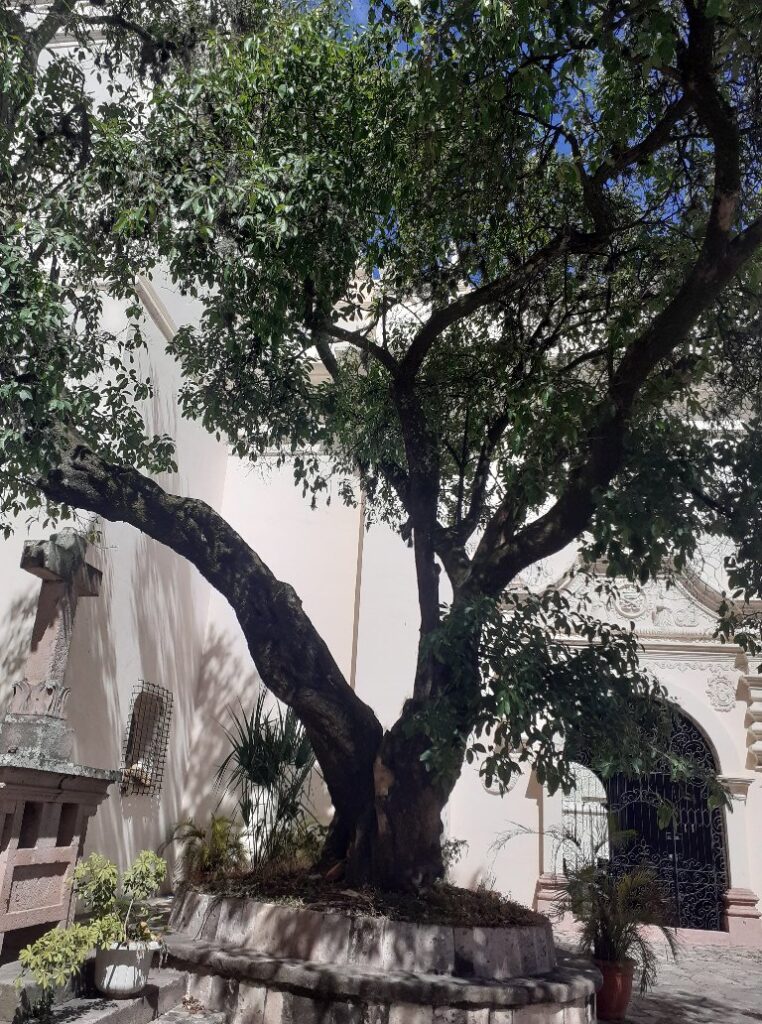

An extremely compelling example of archaeobotanical research can be appreciated in Cameron L. McNeil’s “The Flowery Mountains of Copan: Pollen Remains from Maya Temples and Tombs” in which she describes how she collected samples and undertook pollen analysis to work with microscopic evidence as a way to positively identify four plants used ritually at this particular ancient Indigenous site in Honduras: Zea mays (maize), Typha (cattails), Acrocomia aculeata (coyol palm) and Bourreria huanita (popcorn flowers, also called ik’al te and esquisúchil), which, together, also constitute valuable olfactory information in this sacred context. Bourreria is especially significant in that, according to McNeil, “its lovely, sweet-smelling, yellow-centered white flowers would have imbued the buildings with a powerful paradisiacal fragrance,”[19] a species capable of “possibly channeling the breath soul of the deceased ancestral parents of the polity, or perhaps ushering them on to their flowery paradise.”[20] In her exemplary study, McNeil laments a sad reality: “Various scholars have written about the flowers probably used by the Maya in the pre-Columbian period, but no one has analyzed the microbotanical remains from temple and tomb floors to determine exactly what flowers actually had a role in rituals. This is unfortunate; archaeologists have swept away a wealth of information on ancient plant use as they uncovered the stone, stucco, and dirt of ritual spaces.”[21]

As deeply inside as we were able to go on our fantastic voyage courtesy of the confocal microscope, close enough to get a big bonk on the head from a giant pollen grain of Banisteriopsis caapi, Dennis J. McKenna went far deeper into the enigmas of the natural world during a visionary experience with ayahuasca that he had during a session with the União do Vegetal (UDV) religious group outside of São Paulo, Brazil in 1991. This is how McKenna brilliantly describes the beginning of the revelatory journey that changed his life: “Somehow I understood—though no words were involved—that the Banisteriopsis vine was the embodiment of the plant intelligence that embraced and covered the earth, that together the community of plant species that existed on the earth provided the nurturing energy that made life possible […] By this time I had been given the wordless understanding that I was about to witness, indeed, participate in, the central mystery of life on earth; a water molecule’s eye view of the process of photosynthesis.”[22]
I hope it is evident by now how, in these confocal images of sacred plants from the Americas, the stomata, dermal tissue, trichomes, xylem and pollen, with their distinct forms, colors, juxtaposed textures and composition, aspire to be art, creating an aesthetic proposal that has never been seen before and cannot be repeated in precisely the same way again. These confocal images are abstract art, yes, but contain, as Werner Schmalenbach might say, “a genuine claim to reality”.[23] In the introduction to From Energy to Information: Representation in Science and Technology, Art, and Literature (2002), Bruce Clarke and Linda Dalrymple Henderson make the following assertion: “The sciences readily recognize visualization and imaging technologies as central to scientific representation, which serves us well in rethinking artistic representation as a process of making visible or inventing new combinations of forms or symbols to express a new concept. In fact, the avant-garde of twentieth-century artistic practices did not simply make a sudden leap from representation to total abstraction. It did not abandon representation, but instead forced a breakdown and reconstruction of its operations by attending to the scientific and technological expansion of its applications. In other words, a number of early twentieth-century styles, including Cubism and Futurism and much modern “abstraction,” can be thought of as an artistic remodeling or remediation of scientific representation, in which the visualization of phenomena beyond the range of normal vision—the transformative forms of energy, the medium of the ether, atomic and molecular particles—yield a variety of new pictorial forms.”[24] There is no question in my mind that the origin of abstract art in the first decades of the twentieth-century in painters such as Kandinsky, Miró, Arp, and Klee owes a great deal to the biomorphic forms that emerged from a deep appreciation of microscopic worlds. The microcosmic lives of plants revealed by confocal microscopy now will not only serve as the genesis of innovative pictorial forms, but will enable us to give new life to ancestral indigenous knowledge by means of which the natural world animated the spiritual lives of human beings who seemed to understand more fully the risks of ignoring the importance of living in equilibrium with all species. The plants of Microcosms are a way of entering this consciousness of what has been called an “Archaic Revival”.
To use the critical “lens” of Microcosmic Phytoformalism as an analytical tool requires expensive technology and a highly-trained individual (in our case, my colleague Jill Pflugheber) as well as ongoing institutional financial support to undertake a project of this kind. A transdisciplinary open-mindedness is also extremely important. We were able to exhibit the results of this research, as I have explained elsewhere in the website, at the Brush Art Gallery of St Lawrence University in March 2020. The exhibition encouraged dialogue between the arts/humanities and the sciences in general, but, more specifically with a wide array of disciplines, including Anthropology, Art History, Biology, Caribbean and Latin American Studies, Economics, Environmental Studies, History, Languages, Native American Studies, Philosophy, Political Science, and Religious Studies. Indeed, Microcosms touches on almost every aspect of the traditional way of compartmentalizing knowledge at a typical university, even Mathematics when one begins to calculate the enormous scope of the genocide that occurred during the first century of European colonial rule in Latin America. This website is a democratizing process, a more permanent and widely-accessible repository of plant-teachers and the biocultural history that accompanies them. We consider this an ideal collection of allies who can help us understand what needs to be done in order to halt environmental degradation and climate change. These plants, among my very favorites as an anthologist of vegetal lives, cannot not be together. They interact with each other. We need to know them all better. These digital images are a way of re-knowing, undoing our indifference and ignorance, coming to appreciate the plants of power, and taking this knowledge with us to inhabit the physical world more responsibly. Rob Kesseler, in “Pixillated Pollen,” writes that “the digital world we occupy provides a fertile breeding ground for art-science initiatives.”[25] He proposes “transforming an exotic fusion of scientific knowledge and artistic interpretation into a personal phytopia.”[26] I agree wholeheartedly.
How were the images selected? I quickly became aware while working with my colleague, an accomplished Microscopy specialist, that scientists seek the perfect specimen that exhibits the fullest information. Artists, or those with artistic inclinations such as myself, on the other hand, are attracted to varied states of being with regard to botanical structures, be they collapsed, imploded, fractured, ripped, partially missing, or adorned with imperfect micropatterning—all of this and so much more on the seemingly infinite menus of confocal minutiae. Damage and imperfection, for me, were also legitimate aesthetic marks of existence. But, ultimately, what I was looking for, based on my studies of art history, from paleolithic drawings that I saw firsthand during multiple visits to the caves in northern Spain to the most cutting-edge work in galleries and museums of major urban centers in the United States, Europe, and Latin America over the decades, were images with the power to burn themselves into memory. I found them in these sacred plants, and they will not be forgotten.
Gyorgy Kepes: Vision and Microbiopatterns from the Physical World
I mention the Hungarian-born avant-garde artist, Bauhaus disciple and MIT Professor Gyorgy Kepes (1906-2001) elsewhere in the website as an important antecedent to the confocal images of sacred plants that constitute the Microcosms project. In his fascinating, provocative, and superbly-researched study Gyorgy Kepes: Undreaming the Bauhaus, John R. Blakinger describes an unusual exhibition that Kepes organized at the Massachusetts Institute of Technology in 1951: “Titled The New Landscape, Kepes’s exhibition revealed an entire world that midcentury viewers had never seen before: his abstract images rendered visible the inner structure of microscopic minerals, the outer reaches of the solar system, and everything between the two, from pools of chemical compounds and elastic tissue fibers (seen under 2,000 times magnification) to dense networks of cells.”[27] Among several illustrations taken from the exhibition, Blakinger reproduces a stunning natural image by Kepes himself called “Radial section of redwood: 700x”. Here, the confluence of art, science and technology flows as one to produce a powerful aesthetic experience, through which the viewer’s sense of scale is disrupted by a world from a Sequoia sempervirens that is simultaneously an interior and an exterior, microscopic and colossal. Kepes’s book The New Landscape in Art and Science was based on this exhibition. Assembled in 1952, the book was not published until 1956. Its cover is a haunting radiograph of a rose next to a column of dark patterned holes from a roll of computer punch tape used in mainframe computers of that era. The visual power of The New Landscape in Art and Science, which depends on jarring paired juxtapositions of images presented on facing pages, remains intact, even a lifetime after its original publication in a contemporary world whose biodiversity is threatened as never before by human activity magnified by new destructive technologies.

Texts from this book are linked to the pedagogy of Kepes’s classes at MIT in the 1950s in which he was concerned with “visual design,” “the education of vision,” “pattern-seeing,” and “form-thinking”.[28] Blakinger maintains that Kepes’s methodological approach was “based on combining and connecting anything and everything,”[29] a technique of joining disparate elements in completely unexpected ways, revealing pseudomorphic visual relations. What, exactly, is he trying to connect? As I read this pioneering work, I wrote down the following notes describing some of the images Kepes included for comparative purposes: aerial views of Earth, undersea images, snail’s tongue, staminal hairs of plants, slime mold and the duodenum of a rat! In a strictly scientific sense, these are false comparisons, Blakinger continues, “but they are also purposeful, intended to propel us into the enigmatic realm of the imagination.”[30] Pseudomorphosis, then, became one of Kepes’s principal, signature aesthetic tools. He was an expert “interthinker” and “interseer”, able to reveal these hitherto invisible connections based on visual commonalities. As Blakinger writes, “the task is not factual, but mystical and mythological, similar to ritual acts of divination.”[31]

I am fascinated by Kepes’s work because Microcosmic Phytoformalism as a critical framework for analyzing confocal imagery also depends on an understanding of pattern as microbiological emergence, with all that this generative logic implies. It is a clear extension, as well, of ideas formulated by Lázló Moholy-Nagy (1895-1946), Kepes’s Bauhaus mentor, especially his work in The New Vision (1932). It was from his collaboration with Moholy that Kepes learned how to produce ever more sophisticated experimental art using scientific equipment, such as the microscope. The confocal images here, all derived from living biological material, are clear examples of art as organism. Typically, each slide that my colleague Jill Pflugheber prepared had three tiny specimens from a particular plant, using Fluormount G as the mounting medium (we never employed any kind of staining): the top of a leaf, the bottom and a small sample of a stem. With some of the sacred plants, we were able to work with flowers, too. Jill usually set 10-15 sites on each specimen. It took the confocal microscope about an hour to produce an image from each designated site, carefully chosen and set up with a compelling mixture of her enormous skill and impressive intuition. Thus, the 30-45 identified points per plant required the same number of hours to be transformed into the confocal images from which we made our choices together. In her preface to Art as Organism: Biology and the Evolution of the Digital Image, Charissa N. Terranova describes how images such as these are the product of a “wet biological paradigm” and “distributed technological forces across space and time.”[32] We worked with some fifty different species of plants that I identified in my research and subsequently obtained as live plants or seeds that needed to be germinated with patience (most of these plants I continue to care for now). It took some years to achieve our goals in terms of specific plants that were absolutely essential to include in our limited panorama while also taking into account the importance of as wide a geographical representation as possible throughout the Americas–North, South and in between. Selecting only fifty images for the Brush Art Gallery Exhibit in March, 2020 produced both pride and anguish. Fortunately, we are now able to include a much more ample, though still rigorous, selection for this website.
I have already discussed specific botanical forms (stomata, dermal tissue, trichomes, xylem, and pollen) as sites of informed, aesthetic contemplation within the confocal images. Now, I would like to explore general micropatterns as a way of amplifying the parameters of Microcosmic Phytoformalism. According to Kepes, “a pattern in nature is a temporary boundary that both separates and connects the past and the future of the processes that trace it.”[33] In a variation on this biocentric notion of growth and vision, Kepes maintains that every pattern is a “space-time boundary of energies in organization.”[34] For Susan Stewart, the miniature is “both an experience of interiority and the process by which that interior is constructed.”[35] To me, this is another means of paying homage to the plants by recognizing them as dynamic (never static) biological systems in their own right and also as being part of constantly-changing ecosystems, perhaps in a threatened habitat. The glory of the confocal microscopy technology is that it produces images that have a multi-dimensional, almost kinetic quality. To see the beautiful Datura growing in our friend Becky Harblin’s summer garden was one thing, but being witnesses to the breathtaking textures surrounding a single stoma from the same plant magnified by the confocal microscope was an entirely different and equally gratifying aesthetic experience. Kepes’s “new” landscape required the use of optical devices in order to breach an “ultra-sensory world” of microbiopatterns in remarkable images such as: “Yew Tree, junction of normal and compression wood: 50x”, “Transverse section of root of pine: 100x” and “Transverse section of a stem of Kadsura: 200x”. Similar to our hopes for Microcosms, Kepes intends his images to awaken an ecological consciousness of humanity’s integration into similar patterns on a different scale. He affirms that we, as viewers, return transformed from our voyage in the ultra-sensory world: “Every pattern has its own extension and its wider context as well: it contains or is contained by another pattern; it follows or is followed by another pattern; we know that in personal, biological and cultural life, violent passion and chiseled perfection, growth and equilibrium, revolution and convention follow each other as well as exist side by side. In either case, there is a discontinuity–in time: a rhythmic beat of opening and closing, in space: a demarcation between part and whole—In either case, there is a continuity in the invariants of the transformations.”[36] In The New Landscape of Art and Science, Kepes uses the micropatterns in his art to recalibrate vision and thereby provide an opportunity to encounter plant-difference. Similarly, viewers of the Microcosms confocal images often have expressed to me their initial reaction of shock with regard to the unexpected strangeness and other-worldliness of vegetal otherness. Microcosmic Phytoformalism implies collaboration, a joining of artistic and scientific worlds. As Kepes puts it: “In a closer communion between artists and scientists, it may be possible to work out new visual idioms to reinforce the abstract concept by the powerful, immediate sensory image which conveys the same meaning.”[37] Interdisciplinary collaboration, then, can reveal the hidden forces in nature as images that are suddenly perfectly perceptible, while at the same time maintain their organic aesthetic enigmas intact. It is also a powerful example of learning to educate vision as a way of understanding more fully, as Terranova says, “how a living form develops according to the diverse energies of self-organization.”[38] Since these qualities establish clear links to environmental awareness, they can also be seen as defining characteristics of plant-art, visionary experience imparted by plant-teachers and biodiversity-preserving eco-activism.
What are the possible consequences of embracing technology for the purposes of creating visionary plant-art and fomenting eco-activism? Kepes, who, as I mentioned, taught for many years at MIT, regularly collaborated with colleagues who were deeply-involved with US government military and weapons research during the years of the Vietnam War and, consequently, faced some real dilemmas with regard to science, art and technology. His optimistic, utopian hope was that art was going to transform or convert the technology used for destructive purposes. I agree with Blakinger’s assessment that there was a subversive quality to the way that Kepes infiltrated the sciences and appropriated technology for his own progressive purposes: “Kepes adapted science’s images to new ends—ends that were clearly not scientific. Through a strange alchemy, he transformed them into tools for cultivating creativity: visual patterns, if understood creatively, might teach more creative habits of mind and patterns of being. Sight might provide insight. Kepes’s imaginative approach to the image thus opposed rational, technical, and logical discourse, the very discourse that supported research into weapons and warfare. These visual records were created as objective evidence, but in Kepes’s hands they became sites for subjective projection.”[39] Really, the altered micro and macro scales that are evident in Kepes’s provocative, jarring anthologies of scientized art based on botanical sources are preludes to what Kepes hoped would produce altered states of consciousness and new ways to exist in this world. In terms of the Microcosms project, if I could find the resources, and inspired by Kepes’s 1951 exhibition, I would select from among our confocal images some powerful psychoactive plants–Cohoba, Yãkoana, Ayahuasca, Chacruna, Chaliponga, Ska Pastora, Floripondio, San Pedro, and Peyote—and project them as giant holograms so that viewers could walk through this micropatterned technological shamanic garden and come into being in that display, interacting with nature in that way, since, as Kepes has written, “participation in a work of art often provides us with deep insight into the world […] The analogous relation, transcending both individual human beings and the work of art, becomes a social fact.”[40]
In his last years at MIT, Kepes became more involved in plans for civic-scale projects in public places linked to his environmental concerns. His ideas, which would exist solely on paper, were utopian fantasies: Light Towers with ecological sensors and pollution abatement equipment installed in them, for example. Blakinger maintains that, for Kepes, pollution was both literal and metaphorical, causing contamination of air and water, certainly, but also psychological and cultural fallout: “Environmental art would aim to clean actual toxic emissions but also this mental and social pollution, the dulled aesthetic sensibility Kepes identified as equivalent to ecological damage.”[41] Kepes, in the 1970s, genuinely hoped to transform military research at his institution into environmental investigation to benefit humanity, but he also envisioned the terrifying possible uses of technology, entirely unconcerned with aesthetics, that could very well be applied as an attempt to ameliorate what we now call a profound climate emergency. In his impassioned and prophetic essay “Art and Ecological Consciousness,” Kepes affirms: “And if not properly guided our immensely potent technology may carry within itself curses of even more awesome proportions.”[42] In an interview with Elizabeth Kolbert about Under a White Sky, a book that examines the potential consequences of planet-altering technologies, Jonathan Watts asks the author about whether “writing the book made Kolbert more or less enthusiastic about human interference?” Kolbert replies, “My adventures with some of these scientists who work on really cutting-edge projects with gene editing, with carbon dioxide removal, with geo-engineering, did force me to confront some of my own deep seated and unexamined mental habits. The question of how to feel about that – whether we are entering a brave new world that is exciting or a brave new world that is horrifying, I hope to leave that up to you.”[43]
Kepes believes that there are clear links between human consciousness, environmental awareness and the creative imagination. Reiterating his ideas from The New Landscape (1956), sixteen years later in his “Art and Ecological Consciousness” (1972) essay, Kepes, fascinated by morphogenesis (how biological shapes develop), remains convinced that every living thing, including humans, of course, but also our thoughts and feelings, is marked by patterns subject to more all-encompassing designs linked to the outside world: “Every physical form, every living form, every pattern of feeling or thought has its own unique identity, its boundaries, its extension and its wider context; it contains or is contained by another pattern; it follows or is followed by another pattern. The unique identity, discrete shape, and nature of a space-occupying substance are shaped by the boundary that separates it from and connects it to the space outside. An organic form lives and grows only through its intricate transactions with the environment.”[44] The destruction of the physical world through human, industrial and radioactive waste, deforestation, and loss of biodiversity entails other consequences for humanity, including damage to “all our languages, verbal and visual,” impeding us from “attaining a higher, richer sensing of life.”[45] In this essay, Kepes posits the idea that “environmental homeostasis on a global scale is necessary to survival,” adding immediately that this can be achieved through an artistic sensibility, which “can be seen as one of our basic, collective, self-regulating devices that can help us all to register and reject what is toxic and find what is useful and meaningful in our lives.”[46] Kepes concludes his essay by establishing a fundamental link between science and art that can also be applied to the Microcosms project perceived in light of the critical framework of Microcosmic Phytoformalism: “What scientists considered before as substance shaped into forms, and consequently understood as tangible objects, is now recognized as energies. In the visual arts, painters and sculptors have arrived at conclusions not unlike those of the scientists. Artists have liberated their images and forms from the inhibiting world of object. Painting has become the capture and arrangement of visual energies.”[47] I believe that the confocal images of sacred plants of the Americas, based on living biological material and presenting life as a process in three-dimensional form through laser technology is an excellent example of creating dematerialized plant-art through these “visual energies” to promote environmental awareness and also, by means of spiritual exercises with psychoactive plants themselves, to explore human consciousness. I was pleasantly surprised to see that Kepes (who was 66 years old in 1972 when he published this essay) quoted from Jimi Hendrix’s well-known paean to Owsley Stanley’s LSD “Monterey Purple”: “’Scuse me while I kiss the sky”! Right on, Gyorgy! The confocal images render visible the microbotanical patterns and shapes of stomata, dermal tissue, trichomes, xylem and pollen as plant-art. Kepes would want us as viewers not only to internalize them but to be them and thereby open our creative capacities to solve the environmental crisis that could very well result in human extinction: “The uncharted space is within ourselves, in our still unfathomed ethical potentials, in our still untapped imaginative power.”[48]
As attracted as I am to Kepes’s innovative thinking with regard to art, science, technology and environmentalism, it is marked by a somewhat anthropocentric quality characteristic of its time, despite Kepes’s earlier Bauhaus biocentric origins. Over the last fifty years, it has become clear that the crisis provoked by human activity in the age of the Anthropocene is not merely about humanity being able to lead richer lives, but about creating a new equilibrium between all the species so that a respectful coexistence is possible in a world in which ecocide should be established globally as an international crime. The construct of the Great Chain of Being that places Homo sapiens at the pinnacle of the hierarchy is not now, nor ever was, sustainable or just. The time has come, though it is probably already too late to avoid the coming catastrophe, for human consciousness to be dethroned in favor of plant consciousness.
The website of the Center for Democratic and Environmental Rights (CDER) includes information about the Rights of Pollinators and their supreme importance to the world food supply. Isn’t it time to create a category for the Rights of Sacred Plants, these special vegetal entities and powerful emissaries that deserve the right to exist and flourish? Perhaps these plants, many of which have been respected and cherished for millennia by a variety of indigenous groups, would appreciate this kind of legislative assistance (at municipal, state, national, regional and global levels) in their habitats currently threatened by destructive human behavior. Shouldn’t the U. S. Constitution, for example, an 18th-century document built on property and commerce, be updated to include some new, very old non-eurocentric and non-anthropocentric ideas with regard to the human relationship with the natural world? Perhaps a team of truly American specialists can seek continental inspiration in the Constitution of Ecuador, ratified in 2008, in which “Nature, or Pacha Mama, where life is reproduced and occurs, has the right to integral respect for its existence and for the maintenance and regeneration of its life cycles, structure, functions and evolutionary processes.”[49] According to the CDER website, articles 71-74 in the Ecuador Constitution “also secure the right of nature to be restored, restrict harm to species and ecosystems, and empower communities to protect and enforce nature’s rights.”[50] The future wellbeing of the planet may depend on lawmaking to force necessary cultural change.
I fervently hope that the extended, ultra-sensory worlds revealed by the Microcosms project will contribute in some small way to new forms of egalitarian thought and laws that provide the earth, its waters and its atmosphere protection from the violent human exploitation that must become as unthinkable and impermissible as slavery. The physical world has many powerful human enemies who will stop at nothing to perpetuate the same models of business as usual with their extractive systems that will eliminate finite natural resources in the interest of accumulating capital. It should be said that the formidable array of psychoactive plants of power throughout the Americas were always used by the Amerindian population as a necessary tool for maintaining shared cultural values with regard to the environment and also as an effective technology to wage war and defeat their adversaries, no matter how strong they appeared to be.
Art as Organism: Biology and the Evolution of the Digital Image by Charissa N. Terranova is a complex study that links the biological origin of the digital image with human consciousness. The author wants us to understand our capacity for awareness as “a process between fields of life rather than contained within the brain of an individual.”[51] In other words, this process is both interior and exterior and cannot be entirely self-contained. “Conscious knowing,” she continues, “is autonomic and relational. It is becoming and in passing–crossing through the body by way of the nervous system, then spanning out into the world.”[52] Her comments with regard to the digital image are especially interesting since they are applicable to what we are attempting to achieve with the confocal microscopy that is the basis of the Microcosms project. Terranova draws on the work of Kepes’s colleague Lázló Moholy-Nagy and writes that “the flows of light and electricity extend mind beyond the brain, across the envelope of the body, into the living and non-living material of the world.”[53] In this sense, the confocal images oblige the viewer to be simultaneously inside and outside the sites of aesthetic contemplation in keeping with the critical framework of Microcosmic Phytoformalism. The observable stomata and grains of pollen, for example, extend our minds, taking us outside ourselves and placing us in contact with non-human systems and vegetal lives. What are the potential resulting benefits from this relational knowledge? Terranova maintains that art as biology can “ecologically balance and knit disparate people and societies together into an open and mutating oneness”[54] and also that the biological “becomes an expressed ecology of resistance.”[55] I would also suggest that this new perspective helps us understand and respect the natural world. We learn to perceive bio-empathically. Terranova summarizes the importance of the digital image in a multi-dimensional way, describing it as “behavioral, exploratory, biologically alive, ecological, mutative, and molded and catalyzed by technology.”[56] In short, then, confocal microscopy is an enabling, relatively new technology that allows us to understand human consciousness as relational knowledge. These connections across species link us with a wide range of biodiversity. The spiritual use of psychoactive plants has been an integral part of Amerindian traditions over centuries (in the case of Banisteriopsis caapi) and even thousands of years (with regard to Anadenanthera spp. and Lophophora williamsii). Our limited vision robs us of the power to see, which is precisely why the cognitive technologies of the confocal microscope and the visionary plants are so valuable. Both the microscope that “sees” the plants in innovative ways and the plants themselves are tools to reveal the hidden forces of nature and the cosmos. Both permit us to widen our perceptual base and to amplify the parameters of the known world. One hopes that this knowledge will oblige humanity to cease its highly-destructive anthropocentric activities that are jeopardizing the survival of life on the planet.
Most of these visionary plants are associated with the generation of cosmic designs that are painted on bodies, on communal homes, and on ritual objects. They also manifest themselves as spiritual patterns invoked in trance and song and placed on human skin for the purpose of curing illness. In “Design Therapy,” Angelika Gebhart-Sayer discusses her work with Shipibo-Conibo healers in Peru and how shamanic song “assumes the form of a geometric pattern…which penetrates the patient’s body and settles down permanently. According to the shaman, the healing pattern is a result of his song. Unless he falls ill again, it remains with the patient even after death to help identify his spirit as a Shipibo-Conibo in the other world. The Hummingbird spirit, Pino, described as the “writer” or “secretary” among the higher spirits, now hovers above the patient and lets the design configurations drop onto the patient’s body, swishing, whirring, humming, busy with tiny movements.”[57] These healing patterns produced by the songs of sacred plants received and sung by traditional healers are not unrelated to the patterned energies designating wholeness and oneness of being that Kepes describes on a microbiotic level. What else does it mean to live as part of a pattern-producing process or to be subsumed in greater patterns upon death?
In addition to designs being generated by plant-songs through synesthesia, are there other explanations as to the origin of the actual patterns that appear in an altered state of shamanic consciousness and are then reproduced on the human body as tattoos with the juice from the fruit of Genipa americana (also known as Jagua and Genipapo) or painted on the external walls of malocas (communal houses) and ceramic vessels? I can personally attest to the strong resemblance between the designs of the dermal tissue in Psychotria viridis (clearly visible in these confocal images) and the altered state produced by the sacred beverage ayahuasca. The visionary experience of ayahuasca, however, is far more complex and profound than a single pattern or series of interrelated patterns that one attempts to move through and beyond. Another theory that struck me as worthy of further investigation appears in Microbes and Other Shamanic Beings by César Enrique Giraldo Herrera, who defines entoptic microscopy as a phenomenon that “allows the perception of the viewer’s own retinal structures, blood cells, microscopic particles flowing through retinal capillaries, and of microbes during systemic infections.”[58] For the author, a scientist of Colombian origin, “shamanic visions may be a subjective means to engage with microbes, entities recognized by biomedicine as the causal agents of many of the infectious diseases shamans claim to diagnose and treat, which, moreover, are crucial players in the working balance of the ecological communities they claim to manage.”[59] He wonders if “psychoactive substances employed by shamans augment sensibility to light,”[60] hypothesizing that “shamans have developed enhanced techniques of entoptic microscopy.”[61]
Greine Jordan, a graduate student in Art at the University of East Anglia, is the author of a succinct and richly-illustrated dissertation titled Art of the Brain: Neuroplasticity and Hallucinatory Designs that brilliantly delineates the long-running discussion as to whether this visionary imagery (from Tukanoan groups studied by Gerardo Reichel-Dolmatoff to Peruvian Amazonian artist Pablo Amaringo) has a biological or a more culturally-specific origin. She includes, of course, many references to Reichel-Dolmatoff, especially his comparative drawings of hallucinatory design motifs and phosphene patterns. But she also incorporates current scientific research on this subject such as the investigations undertaken by Semir Zeki, David Lewis-Williams and a Brazilian team of scientists led by Draulio B. de Araujo. De Araujo summarizes his work on the brain in the following way: “Using functional magnetic resonance imaging during a closed-eyes imagery task, we found that Ayahuasca produces a robust increase in the activation of several occipital, temporal, and frontal areas […] Therefore, our results indicate that Ayahuasca seeings stem from the activation of an extensive network generally involved with vision, memory, and intention.”[62] A key term in Jordan’s analysis is “neuroplasticity,” which she defines as “the ability of neural connections to form and disband depending on experience and actions.”[63] Her conclusion, not surprisingly, is that social norms and biology are both important in the image-generating and image-interpreting process. She postulates that “the form of these designs, the hallucinations themselves and the meanings associated with them are shaped by neuroplasticity, demonstrating that culture and neurology reciprocally shape each other.”[64]

During the summer 2000, I had the privilege of being able to accompany Luis Eduardo Luna on a research trip to several cities in the Peruvian Amazon. While in Pucallpa, we visited Pablo Amaringo in his studio at the USKO-AYAR Amazonian School of Painting. Although I was already very familiar with Amaringo’s collaboration with Luna for the collection of paintings and supportive commentaries in Ayahuasca Visions: The Religious Iconography of a Peruvian Shaman, my direct conversations with Amaringo confirmed an important aspect of his artwork, namely, their visual narrative quality. He had the habit of working on many paintings simultaneously, and it was clear in hearing him speak about them that each had a story to tell. Amaringo’s paintings compressed the events in time into one kinetic perimeter. It was like seeing an entire film in a single frame. This brings me back to one of Kepes’s central ideas: the narrative quality of organic growth and their patterns. The conflicts, tensions and organized energies that characterize the shamanic warfare in Amaringo’s paintings tell a story not unlike the one that can be deciphered in the micropatterns of the leaves, stems and flowers of sacred plants as revealed by the confocal microscope.
There are many powerful sites of indigenous Amazonian art, difficult as they are to actually visit due to their remote locations and the violent nature of Colombian sociopolitical realities from the 1960s to the present. In 1943, the legendary ethnobotanist Richard Evans Schultes (1915-2001) traveled to the Colombian Amazon and saw many petroglyphs, especially on the Pira Paraná River (a tributary of the Apaporis), including the famous “Rock of Nyi”. Scroll down on this extraordinary story map to see photographs taken by Schultes of this image that marks the mythic origin of humanity, according to Tukano culture. The text in this interactive website that describes Schultes’s journey focuses on specific places in the landscape, making visible ancestral knowledge linked to the land, and also highlights terrestrial-celestial correspondences in keeping with the indigenous perspective: “To the everyday eye, these sites appear to be rocks, rapids, rivers, mountains, and salt licks, but local shamans report that they see an invisible realm with huge, beautifully decorated malocas full of men adorned with intricate ceremonial regalia. Indigenous groups of the Apaporis groups believe the sacred sites are important locations from which the vitality of the universe emanates, and are repositories of traditional knowledge. They believe the sites to be alive, interconnected, and imbued with an invisible power known as “ketioka”. Each site has its own origin myths and a connection with a specific aspect of indigenous life, including animals, ceremonial dances, warfare, medicinal plants and curing rites.” With regard to these vegetal lives, I would like to think that Microcosmic Phytoformalism also provides insights into their macrological world and their relationships with multiple species.
Another sacred site, Chiribiquete, the so-called Sistine Chapel of the Amazon, is located in the Serranía La Lindosa in Colombia and contains thousands of examples of rock art (that may be up to 20,000 years old) painted by members of the Karijona indigenous group:
It is quite likely that the sacred plants depicted in this astonishingly beautiful arte rupestre include at least two that form a part of the digital repository of the Microcosms project: Anadenanthera spp. and Erythroxylem novogranatense (Coca). For Carlos Castaño-Uribe, Chiribiquete is a compendium of visionary art that shamanic pilgrims could add to themselves and also observe in its ancestral abundance an “inexhaustible source of neuropsychotropical stimulus” to propitiate an altered state of consciousness, a way of using the art itself “to renew the energy and power of the trance.”[65] What it means to gather images generated by the confocal microscope (with their inspirational value that may function in ways not entirely unlike the phytomorphic creative expression at Chiribiquete) and make them accessible in this website will be the focus of the final part of this essay.
An Ecodigital Repository of Biocultural Heritage
In his indispensable, groundbreaking book Posthuman Plants: Rethinking the Vegetal through Culture, Art, and Poetry, John Charles Ryan discusses how “the maintenance of the world’s biocultural heritage should become a moral obligation.”[66] The dozens of plants assembled in the Microcosms website are revered by Amerindian groups throughout the continent and, collectively, form an alternative cognitive map based on a deep ancestral knowledge of vegetal technologies. In this repository, the digital images of these sacred plants generated through confocal microscopy can be seen together in this innovative way and admired for the astonishing aesthetic nourishment they provide. Though not a comprehensive collection, Microcosms is still a formidable beginning in the process of creating a site for the study of the biocultural heritage of many of the most important plant-teachers from the American continent. In his book on shamanic snuffs, Jonathan Ott expresses his amazement at the vast geographical extension and interrelatedness of these plants of power across time: “We are faced here with a single, archaic, intricately-intercalated, tropical inebriant-complex which is pan-South American, and indeed echoes down the broad and profound corridors of the past, to southern Argentina and Chile, and north through Mesoamerica, encompassing at least the tribes of Northern California, possibly even those of the Northwest coast.”[67] In other words, this is not an unnatural, forced conjoining. These plants are all here because they do indeed belong together. The unity of their living microcosmic presences also has a great deal to do with their macrocosmic lives, their habitats and the diverse, interconnected ecosystems that join them with us. As I’ve mentioned, the confocal images, in conjunction with Microcosmic Phytoformalist analysis, open sites of contemplation that were previously imperceptible. They are as much a part of an invisible landscape revealed as sacred sites of rocks, waterfalls and mountains that divulge their secrets when one learns how to listen not only to human oral traditions, but also to vegetal narrativity with or without the spiritual use of psychoactive plants.
The tragic history of the Americas during the colonial period (and beyond) in many ways can be understood as the violent assault by European invaders on the sacred plants and the indigenous leaders who consulted these plant-teachers as a way of benefiting their societies and learning how to live in greater (though hardly perfect) equilibrium with the natural world. It is not my intention to idealize or romanticize indigenous cultures that clearly left their human mark on the landscapes they inhabited and shaped. To facilitate the looting of the continent, the foreigners first needed to destroy the gods of their new slaves, as well as the food and religious ceremonies that sustained them. I’ve dreamt of Spanish soldiers furiously chopping down the red plumes of amaranth,

bursting into healing rituals to confiscate the cohoba of a Taíno shaman, destroying the mushroom-children of one of María Sabina’s ancestors, torturing indigenous prisoners to extract ever more information about the vegetal lives that are such an integral part of Amerindian lives, banning the use of ayahuasca upon pain of condemnation to infernal realms, burning the botanical knowledge preserved in codices, and demonizing the systems of cosmic plant-patterns that oriented pre-Hispanic existence. These official impositions, though challenged in the contemporary world, largely remain intact and seriously endanger anyone who denounces and breaks these unjust and hypocritical laws.[68] I’m remembering, too, my journey to the Ecuadorian Amazon in the late 1970s when I visited a Cofán community and saw firsthand how Evangelicals from the United States had decimated all ancestral traditions related to the use of sacred plants. The only thing there that saddened me more was the recently-finished 500 km. pipeline snaking from Lago Agrio over the Andes toward the Balao Pacific port, carrying the oil that ruined so many lives and ecosystems. Christianity and extractivist economies have been operating together with devastating consequences for indigenous peoples in Latin America for centuries.
The importance of plants (many of which are included here) in all aspects of Amerindian life cannot be overestimated. Amerindian cultures certainly understood the economic qualities of plants and the need to equitably feed their populations, but they also possessed a highly-refined sense of aesthetic appreciation of them, especially the flowers in their everyday lives and religious ceremonies. I delineate many of these diverse spiritual and quotidian uses in the descriptions I provide for each plant belonging to this ecodigital repository. For decades at St Lawrence University, I taught Latin American literature and its pre-Hispanic (Mayan, Aztec/Mexica and Incan) origins. One of my favorite concepts to discuss with my students was Xochicuícatl, flor y canto, the flower-song that underlies the Náhuatl philosophy of the wise king of Texcoco and poet Netzahualcóyotl (1402-1472). Flowers have fragile bodies in keeping with the brevity of all life while at the same time are a presence of permanence in Netzahualcóyotl’s sung poem that resists the passage of time to delight readers such as ourselves, working with a translation of a translation more than five hundred years after it was composed according to an oral tradition in its original language. There is good reason to believe that this ruler, philosopher and poet also encouraged botanical research in Texcoco, establishing beautiful gardens, herbariums, schools and libraries. Here is a famous Xochicuicatl as translated first from Náhuatl into Spanish by Ángel María Garibay, followed by my version in English:
Quin oc ca tlamati noyollo:
Niccaqui in cuicatl,
nic itta in xochitl:
Maca in cueílahui!
Hasta ahora es feliz mi corazón:
oigo ese canto,
veo una flor:
¡que jamás se marchiten en la tierra!
Finally, my heart is content:
I hear that song,
I see a flower:
may they never wither on earth!
The poem-song seems simple enough, but the more one thinks about it, the more complex it becomes. For me, the arresting confocal images gathered in this storehouse have a great deal to do with Netzahualcóyotl’s Xochicuícatl: a striking manifestation of both vulnerability and durability. The notable difference is that the infinitesimal sculpted truths of pollen will outlast by far all our books!
At this point it is important to mention the pervasive greater Mesoamerican (understood as Central America, Mexico and the southwestern part of the United States) concepts of a blossoming paradise that are described in Flower Worlds: Religion, Aesthetics, and Ideology in Mesoamerica and the American Southwest. In their introduction to this remarkable collection of essays, the editors, Andrew D. Turner and Michael D. Mathiowetz, affirm what should be considered an important message to contemporary humanity: “flower worlds exist in the landscape—revealed or “unconcealed” to those who are prepared to experience them.”[69] Olmec, Maya, and Mexica flower worlds, manifesting themselves in their material culture, consist of colorful flowers in abundance, radiant jewels, bright butterflies, and birds with iridescent plumage such as nectar-sucking hummingbirds which were thought to be actual embodiments of ancestors (and, for the inhabitants of Teotihuacan, fallen warriors) not merely representations of them. Additionally, they include dawns, sunsets, rainbows, glittering drops of water, in short, any luminous, chromatic, awe-inspiring revelation of the life-generating forces of the sacred cosmos. In her overview of this innovative research, Kelley Hays-Gilpin summarizes why it is incumbent upon us, in our fraught world threatened by climate change, to pay close attention to these ancient ideologies: “Perhaps more important, insights gained from monistic, animistic, and pantheistic worldviews such as that of the flower worlds may prove to be a basis—the basis?—for a rejection of the Western culture/nature dichotomy that when enacted through settler colonialism, industrialism, and now predator capitalism has radically degraded our global environment to the brink of disaster.”[70]
The same species included in the website were once studied and classified by indigenous botanists, who were nobles and the first to be in contact with the Spaniards.[71] They were also the first to be baptized by force and the first to succumb to diseases brought by the invaders, a phenomenon that can be characterized in general as an obliged acculturation that produced the death of the botanists and the destruction of the botanical codices they created as well as the schools in which they imparted their knowledge. There are some noteworthy exceptions to this destruction during the colonial period, especially the work of Fray Bernardino de Sahagún (1499-1590), ethnographer of Náhuatl life and customs and author of the Florentine Codex that contains (in Books X and XI) extensive descriptions of medicinal plants and their pharmacological uses. The good Franciscan also listed the names and places of origin of the indigenous healers who were his informants. Even so, I wonder how willing these informants were to collaborate with Sahagún’s compilation and if they had to be physically coerced. Time after time in my research on individual plants for the Microcosms project, I noted a deep remorse and reticence that often emerged in published sources on the part of indigenous collaborators working with mestizo and foreign anthropologists and scientists (María Sabina, Maya midwives and Mapuche machis, are a few examples that immediately come to mind) about sharing information related to medicinal plants. This, of course, is perfectly understandable given the well-known history of outsiders exploiting indigenous ancestral knowledge. An interesting twist in this ongoing story is the work funded by the Peru- and US- based non-profit Acaté Amazon Conservation to create a 1,000-page encyclopedia for safeguarding the accumulated plant-knowledge collected from Matsés tribal elders and ensuring that this information and supplementary maps are available exclusively (purposely untranslated) in their indigenous language from a small community in the Peruvian Amazon.[72] This ancestral knowledge, always in danger of disappearing, is threatened more than ever as a result of the devastating onslaught of the coronavirus pandemic throughout Amazonia.
But isolation, both physical and linguistic, may not be an entirely viable option. The outside aggression of gold prospectors and construction projects entailing massive deforestation ravaging Yanomami territory in Brazil, for example, are producing ecological crises so severe now that Davi Kopenawa, a Yanomami political and religious leader with a vast knowledge of sacred plants, is very clear about the consequences on the horizon and the need for him to communicate with people beyond his immediate community and even his country:“This is why I would like the white people to hear our words and dream about all they say: if the shaman’s songs stop being heard in the forest, white people will not be spared any more than we will.”[73] For Kopenawa,[74] yãkoana (Virola spp.) is the plant that makes the gods (xapiri) float gently in place like hummingbirds or bees and illuminates the song-trees in the distance, inviting him to learn their words and music. Yãkoana, a member of the nutmeg family, was the hardest plant for us to find, but it has its space with its microcosmic splendor as part of this digital repository. Kopenawa has clear ideas about outsiders attempting to use this sacred plant: “Yãkoana is not good for them (the white people). If they start to drink it on their own, the angry xapiri will only entangle their thought and make their stomach fall in fear. Its images, which we call yãkoanari, only has friendship for the people of the forest.”[75] Fair enough. Perhaps having potent Virola snuff blown with force through a long bifurcating tube into both nostrils simultaneously is only for “the people of the forest,” though the current global spread of ritual ayahuasca use among widely-diverse ethnic groups might challenge that legitimate concern, especially when the very existence of the Amazonian rainforest is at stake.
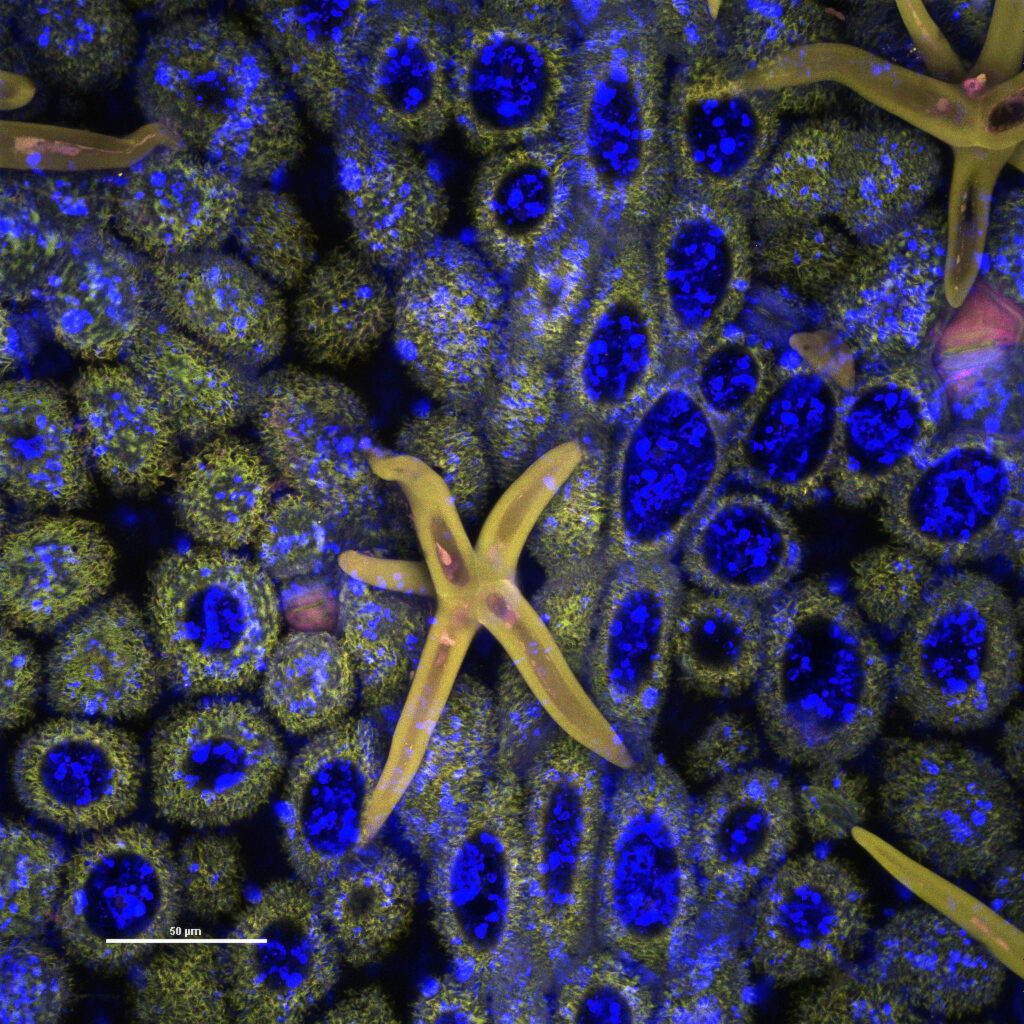
Kopenawa’s life is documented in a riveting first-person narrative with both mythic and epic qualities called The Falling Sky: Words of a Yanomami Shaman and was produced in collaboration with a French anthropologist who has known the Yanomami activist for decades. Clearly, this testimony linked so intimately to plants held sacred by an Amerindian group inevitably becomes part of the Microcosms repository of biocultural heritage. And there are many others associated with a variety of plant-teachers, including the fascinating life-story connected to yajé/ayahuasca as told by Fernando Payaguaje, that are available in published form.[76] Ryan correctly points out that “human memories of nature are catalyzed or deepened by direct reference to living things, meaningful objects, or important places.”[77] Thus, continues Ryan, “tangible botanical heritage and intangible botanical heritage are inextricably related in theory and practice.”[78] Generally, most of these stories will never be known outside of a very small indigenous community or beyond a young apprentice.

The production of this intangible biocultural heritage includes the ethical obligation of recognizing and expressing gratitude to one’s own teachers, as did Luis Eduardo Luna (he and I worked and reworked two editions of Ayahuasca Reader) when he received an honorary degree, Doctor of Humane Letters, from St. Lawrence University in 2002. I was delighted to discover a copy of his speech among my paper files recently and would like to quote some of his wise words that were delivered that unusually cold May day to a sea of university dignitaries, graduating students, their families and the entire faculty: “I have dedicated my life to reveal the light of ancestral knowledge that was kept alive not only among indigenous Amazonian groups, but also among the mestizo riverine population of the Upper Amazon. Year after year, I spent whatever time I had available to record songs and narratives, to collect and stimulate the production of art in some areas of the Amazon, and to learn from the plants what many Amazonians regard as the source of their knowledge. I learned that in Amazonian thought there are fluid boundaries between what we distinguish separately as art, poetry, ritual, medicine and science, a world in which a song that invokes an animal and is learned from a plant can be used to promote a person’s health by stimulating his or her own internal resources by means of suggestion, imagery and metaphor. It was clear to me that for thousands of years, and living in the world’s richest biological environment, the Amazonians have developed techniques that are effective in ways that Western science can no longer afford to ignore.”[79] Luna then proceeded to identify by name his Amazonian teachers: Don Apolinar Yacanamijoy, of the Ingano, Don Basilio Gordon, of the Shipibo, Don Salvador Chindoy, of the Kamsá, as well as the Peruvian mestizo shamans Don Emilio Andrade Gómez,[80] Don José Coral and Don Miguel Ahuanari.
There are strong links to be forged in this repository with its designated outside references between people offering first-person testimonies as intangible biocultural heritage and plants that communicate in the botanical “I”. John Charles Ryan elaborates on this in his brilliant study Plants in Contemporary Poetry: Ecocriticism and the Botanical Imagination: “As subjects with their own experiences, remembrances, and affective modes, plants speak in the first person.”[81] Especially compelling in Ryan’s approach is his characterization of a vegetal dialectic: plants affect and are affected, feel and are felt, sense and are sensed, remember and are remembered, imagine and are imagined.[82] The first person human and the first (plant) person singular can be multiplied to become, together, a powerful first person plural (“We”). Ryan might say that Luna learned from the Amazonian indigenous and mestizo healers who were in direct conversation with the very plants that “manifest the sacred in and through their everyday ontologies.”[83] For this reason, the Microcosms website should be considered a place for people and plants to be and to become together. It is a digital repository of plant-art, an archive of ancestral knowledge, a heritage-site that preserves the memory of precarious lives, both human and vegetal.
For me, the boundaries between tangible and intangible biocultural heritage begin to disappear when plant-consciousness thoroughly permeates then transforms human consciousness, opening a first (shamanic) person voice during ritual use of psychoactive mushrooms and plants, many of which are present in this repository. I am thinking of the chants, songs and sonic patterns that practitioners receive directly from the plants and use to heal the sick. The mestizo and indigenous healers that Luna mentions all work with ayahuasca and a wide variety of plant admixtures. The songs they receive in their lucid dreams come to them in different languages (indigenous as well as Spanish) and can also include syncretic elements from diverse symbolic systems that are Amerindian and Christian. Sometimes, the healers chant and whistle while they make a ghostly swooshing sound with a shacapa (a rattle that is a leaf-bundle of Pariana spp., a member of the grass family). The plants generate many kinds of music in their human collaborators: icaros from Shipibo shamans,[84] Peyote songs of the Native American Church,[85] or the received hymns (especially the poignant series known as “O Cruzeirinho”)[86] of Mestre Irineu, who founded the Santo Daime church in Brazil nearly a hundred years ago.
One particularly important example of this shamanic voice that has been studied in depth are the Mazatec chants of María Sabina (1894-1985) that she received from her niños santos (saint children), mushrooms from the genus Psilocybe.[87] In Soy sabia, hija de los niños santos: mística y conocimiento en María Sabina, a true gem of insightful scholarship,[88] Andrea Pantoja Barco reminds the reader that the Náhuatl name for the sacred mushrooms is teonanáctl, the Flesh of God, “a presence that takes shape as a body and makes bodies sing.”[89] The shaman is often characterized as an intermediary, but it is clear that Sabina, cognizant and accepting of her destiny to cure with the language of the saint-children, considers herself a kind of Cosmic Translator. As she says: “Language belongs to the saint children. They speak and I have the power to translate.”[90] But is it the singular voice of the mushrooms that Sabina is hearing? In July, 2012 Pantoja Barco traveled to Oaxaca and interviewed Sabina’s great-grandson Bernardino García in a sacred elevated place outdoors called the Cerro Adoración. He told her that the saint children “are what enable us to connect with the earth, with the sky, with all the animals, with everything that speaks in nature, and that the mushrooms allow us to hear their voices.”[91] In other words, Sabina’s wise first-person voice, possessed by a non-human Other, has its origin not only in the botanical source of the mushrooms but also the multiple channeled voices of a pantheistic natural world. In her conversation with Estrada, Sabina describes what can only be called a mystical ritual of initiation: “One of the Principal Beings spoke to me and said: ‘María Sabina, this is the Book of Wisdom. It is the Book of Language. Everything that is written there is for you. This book is yours. Take it, so that you can do your work.’”[92] Pantoja Barco characterizes this sacred object received by María Sabina in the following way: “White book as microcosmic intimacy, a mandala-like book where the gods reside, where memory resembles the repetition of a difference, multiplication of sacred space, where wisdom reproduces itself infinitely.”[93] To conclude this brief case study of María Sabina and the transformative interaction of Human-Botanical-Shamanic voice, it is important to take into account Pantoja Barco’s perspective that links Sabina to a lineage, a proudly shared heritage of healers who exercise traditional ancestral knowledge across generations and eras. In this sense, voice must not be conceived as originating solely from a single time: “The body that emerges is the body of nocturnal language, the somnolent body in an altered state and in long vigils of understanding. For María Sabina, to say resembles the act of letting those other voices circle her and then inhabit her in the way they already have been within her since ancient times.”[94] Why should we follow those who sing? “Because there are clean flowers where I am going, because there is clean water where I am going,”[95] beckons Maria Sabina in one of her chants. Or, similarly, as Mestre Irineu puts it in one of his Santo Daime hymns: “Flower on the waters,/Where’ve you been?/Where’re you going?/I’ll be doing some cleaning/In my heart, My Father’s flowing/The dwelling of My Father/Is deep in the planet’s heart/Where all love makes its home/And hides its most secret part.”[96]
Having an ecodigital repository of biocultural heritage with all these plants (and one fungus!) together makes it easier to contemplate family resemblances. The Microcosms project assembles an entire digital gallery full of portraits of these illustrious figures that can be appreciated more profoundly by applying the critical framework of Microcosmic Phytoformalism. After seeing so many confocal images and without being an expert in botany, I found that the formal qualities of stomata, dermal tissue, trichomes, xylem, and pollen do, in fact, facilitate the creation of visual lineages with fundamental commonalities and stark differences. How do we perceive those botanical personages who are before us in the form of digital images? How do we assimilate them in a ritual sense as they impart their vegetal knowledge, sometimes in the form of phonological systems beyond language itself and the meaning of specific words? How do the plants and mushrooms perceive and receive us with our prepared (or unprepared) bodies in a ceremonial context?
The existence of these plants can sustain us as we work to preserve them. This electronic gathering of families and allies constitutes a different kind of ecological reserve. In Posthuman Plants, Ryan writes with admirable clarity about the impetus and importance of eco-activism, arguing that “the receiving of ethnobotanical good should be balanced by a giving back of good to the plants themselves, the environments in which they grow naturally, and the indigenous people whose cultural heritage involves medical knowledge of the species. It is not enough to privilege cultivating healing plants as a solution to their disappearance in the wild. As species decline, the ecocultural knowledge systems associated with them become at risk…”[97] The author understands that, ultimately, the real purpose of the transdisciplinary work comprising this repository is to combat the utilitarian attitudes and economic models that are destroying these same sacred plants and their fragile ecosystems: “However, more recently digital artists have capitalized on the potential of new technologies to express environmental concern, to engage the public in thinking seriously about ecological issues, and, hopefully, to influence policy makers as another, powerful means for change.”[98] Additionally, as humans leave passivity behind and undertake necessary bold changes, we need to remember always that plants, too, are agentic, not passive. Recognizing this will change our relationship with plants in definitive ways. The confocal images collected here are portraits of beings with a particular form of consciousness that allow them to participate and communicate with agency as they interact with humans and non-human elements of an animated landscape. There is a reason why Amerindian religious systems deified Nature itself. If we doubt the efficaciousness of cosmogonies that contribute to the survival of all species, unfortunately, we’re lost. In the Popol vuh, the Hero twins, Hunter and Jaguar Deer, descend into the underworld of Xibalba. They are only able to triumph over the Lords of Sickness and Death when they form close alliances with a wide variety of non-human species. In one of my favorite parts of the narrative, fireflies save the twins from execution by pretending to be the lit ends of cigars of sacred tobacco that were not to be consumed in their entirety during a long night of trials. Thank you, ch’umk’ak’ (“firefly” in Quiché Maya)!
In his extraordinarily gifted English translation of the Popol vuh, Dennis Tedlock speaks of how the “Council Book” itself was considered by the lords of Quiché “an ilb’al, ‘a seeing instrument’ or a ‘place to see’; with this they could know distant or future events.”[99]Curiously, as Tedlock also explains, “today ilb’al […] refers to crystals used for gazing by diviners and to eyeglasses, binoculars and telescopes.”[100] Could this be extended to include the confocal microscope as yet another instrument for augmenting the limits of human vision? And perhaps Microcosms, as a gathering of vegetal lives and their stories in relation to humans, might also be considered a privileged and strategic vantage point, an aesthetic site that reveals better ways to proceed into a future that is bound to be grim and dominated by what most concerned the Maya seers: extreme weather conditions, famine and war.
By way of a conclusion to this essay as part of a free, globally-accessible website produced in a small, remote town in rural upstate New York, on land taken from the Mohawk Nation, I feel compelled, at least initially, to resist the obligatory optimistic note to express instead my shame and indignation about the ways that we, as humans, have misunderstood, mistreated, exploited and demonstrated an utter lack of respect for plants. As Michael Marder affirms in his inspiring study Plant-Thinking: A Philosophy of Vegetal Life, for humanity in general, plants “have populated the margin of the margin, the zone of absolute obscurity on the radars of our conceptualities”[101] and that somehow we feel we have the right to operate on the assumption that “vegetal beings [are] unconditionally available for unlimited use and exploitation.”[102] Obviously, the goal of the Microcosms project with this ecodigital repository of biocultural heritage is not to turn these confocal images of more than forty sacred plants from the Americas into static artifacts detached both from their ecosystems and from the indigenous peoples whose ancestral knowledge has provided the most intimate, immediate understanding of who these vegetal entities are and what they demand from us in their role as emissaries from the natural world. On the contrary, I hope that this website becomes a platform for new aesthetic experiences through technology, a site of resistance to humanity’s predominant “instrumental attitude”[103] toward plants, a means of denouncing the abuses that are producing a mass extinction of plant species, and a call to urgent, empathic, morally-based activism as conservators, creators and informed citizens against the political and economic systems that are so irrevocably harmful to the environment. In the first part of this essay, I presented Microcosmic Phytoformalism in terms of specific plant forms such as stomata, dermal tissue, trichomes, xylem, and pollen that become sites of contemplation, catalysts for an appreciation of microbiopatterns. Each form also has a purpose in terms of ensuring plant survival and, jointly, contribute toward Marder’s powerful definition of plant-thinking: “The living tendency of plants toward their other, the tending expressed in growth, the acquisition of nutrients, and procreation, amounts to the non-conscious intentionality of vegetal life.”[104] This characterization is very compelling in terms of hundreds of thousands of plant species, but perhaps less so for the approximately 100 species of known psychoactive plants, almost half of which are represented here. Should these plants, too, be grouped in the category of “non-conscious intentionality”? What explains the existence of these plants of power and their long relationship with humanity’s attempt to understand the cosmos and coexist in a more egalitarian, interdependent manner with the myriad species of the natural world? Often, the visionary experience leads one to reflect on the distinct possibility of the instrumental attitude of certain plants toward humans! These plants are capable of doing the unthinkable, helping us conquer our individual and collective selfishness as a species so that we can see that we are part of nature. As Michael Pollan says with regard to the new studies on using psychedelics to treat anxiety, depression, addiction and trauma, “What is striking about this whole line of clinical research is the premise that it is not the pharmacological effect of the drug itself but the kind of mental experience it occasions—involving the temporary dissolution of one’s ego—that may be the key to changing one’s mind.”[105] The plants convened here should be considered actants in this tragic tale, guardians, a botanical safety mechanism emplaced for the benefit of all species. These plants can also dissolve the boundaries between the human species and other elements of the natural world. I mentioned the experience that Dennis J. McKenna had when he was transformed by plant intelligence into a water molecule to live the process of photosynthesis. In the Ayahuasca Reader, Nicaraguan poet Esthela Calderón describes the genesis of “The Woman I Could Have Been”, when a bitter drink enabled her to reconstruct herself in this poem as a female “other,” a composite of dozens of plant species that she knows intimately, thanks to generational knowledge passed on to by her mother and her grandmother.[106] A recurrent theme in the Amazonian painting of Pablo Amaringo is shamanic transformation, which also distinguishes the portraits of Colombian artist Jeisson Castillo, who uses cutting-edge technology to project his work on malocas (indigenous communal dwellings) and on public structures in urban centers to promote greater awareness of indigenous ancestral knowledge.[107] The confocal images themselves demonstrate the correspondence that exists between the otherworldly this-worldliness of magnified sacred plants and the visionary experience that they produce in human consciousness. I am humbled by the sheer tenacity and mind-transforming audacity of these plant-teachers, and, in this sense, I thoroughly agree with John C. Ryan, who, in his analysis of the work of Native American poet Joy Harjo, maintains: “In addition to representing and embodying hope, plants can be understood to have hope.”[108] Even if it is too late, as it may well be, we are obliged to heed the calling of the plants and, with the utmost respect, follow their organizational example of modular networks and roots described by Mancuso and Viola as “a kind of collective brain—or rather a distributed intelligence.”[109] Together, we, too, can then become actual bearers of aspiration and commitment, genuinely grateful to share life with these plants and dedicate our lives to them. What will remain if we do not act and fail to wage the only battle that truly matters?
[1] Susan Stewart. On Longing: Narratives of the Miniature, the Gigantic, the Souvenir, the Collection. Baltimore: Johns Hopkins University Press, 1984: p. 54.
[2] https://www.olympus-lifescience.com/en/microscope-resource/primer/techniques/confocal/confocalintro/
[3] R. H. Francé. Plants as Inventors. London: Simpkin, Marshall & Co., 1926: p. 34.
[4] Jeremy Hance. “Amazon Tribe Creates 500-Page Traditional Encyclopedia,” Mongabay (June 24, 2015).
[5] José Reissig. “A Proposal for Softening the Boundaries of Science” in Martin Pollock, ed. Common Denominators in Art and Science. Aberdeen: Aberdeen University Press, 1983: 181.
[6] Ibid. p. 183.
[7] https://www.nikonsmallworld.com/galleries/photomicrography-competition
[8] Emily Brady. “Aesthetic Regard for Nature in Environmental and Land Art,” Ethics, Place and Environment 10.3 (October 2007): 297.
[9] Charissa Terranova and Meredith Tromble. “Introduction” in Charissa Terranova and Meredith Tromble, eds. The Routledge Companion to Biology in Art and Architecture. New York and London: Routledge, 2017: p. 4.
[10] Charissa N. Terranova. “The Epigenetic Landscape of Art and Science c. 1950,” in Charissa N. Terranova and Meredith Tromble, eds. The Routledge Companion to Biology in Art and Architecture. New York and London: Routledge, 2017: p. 267.
[11] Ibid. p. 267.
[12] Jonathan Ott. The Cacahuatl Eater, Ruminations of an Unabashed Chocolate Addict. Vashon, WA: Jonathan Ott Books, 1985: p. 74.
[13] J. P. Hodin. “The Painter’s Handwriting,” in Gyorgi Kepes, ed. Vision + Value Series: Sign, Image, Symbol. New York: George Braziller, 1966: p. 151.
[14] Peter Crane. “Foreword,” in Rob Kesseler and Madeline Harley, eds. Pollen: The Hidden Sexuality of Flowers. Buffalo, New York: Firefly Books, 2009: p. 12.
[15] Rui Wang and A. A. Dobritsa. “Exine and Aperture Patterns on the Pollen Surface: Their Formation and Roles in Plant Reproduction,” Annual Plant Reviews 1 (2018): 1.
[16] Ibid. p. 2.
[17] Ibid. p. 6.
[18] Hope MacLean. The Shaman’s Mirror: Visionary Art of the Huichol. Austin: University of Texas Press, 2012: p. 51.
[19] Cameron L. McNeil. “The Flowery Mountains of Copan: Pollen Remains from Maya Temples and Tombs,” in Michael D. Mathiowetz and Andrew D. Turner, eds. Flower Worlds: Religion, Aesthetics, and Ideology in Mesoamerica and the American Southwest. Tucson: The University of Arizona Press, 2021: 139.
[20] Ibid. p. 142.
[21] Ibid. p. 143.
[22] Dennis J. McKenna. “An Unusual Experience with ‘Hoasca’: A Lesson from the Teacher,” in Luis Eduardo Luna and Steven F. White, eds. Ayahuasca Reader: Encounters with the Amazon’s Sacred Vine. Santa Fe, NM: Synergetic Press, 2016: 323-324.
[23] Werner Schmalenbach. “The Problem of Reality in Mid-Century Painting,” in Gyorgi Kepes, ed. Vision + Value Series: Sign, Image, Symbol. New York: George Braziller, 1966: p. 168.
[24] Bruce Clarke and Linda Dalrymple Henderson. “Introduction,” in Bruce Clarke and Linda Dalrymple Henderson, eds. From Energy to Information: Representation in Science and Technology, Art and Literature. Stanford: Stanford University Press, 2002: p. 7.
[25] Rob Kesseler. “Pixillated Pollen,” in Rob Kesseler and Madeline Harley, eds. Pollen: The Hidden Sexuality of Flowers. Buffalo, New York: Firefly Books, 2009: p. 183.
[26] Ibid. p. 185.
[27] John R. Blakinger. Gyorgy Kepes: Undreaming the Bauhaus. Cambridge and London: MIT Press, 2019: p. 79.
[28] Ibid. p. 95.
[29] Ibid. p. 95.
[30] Ibid. p. 105.
[31] Ibid. p. 105.
[32] Charissa N. Terranova. Art as Organism: Biology and the Evolution of the Digital Image. London and New York: I. B. Taurus, 2016: p. xviii.
[33] György Kepes, ed. The New Landscape in Art and Science. Chicago: Paul Theobald, 1956: p. 205.
[34] Ibid. p. 206.
[35] Susan Stewart. On Longing: Narratives of the Miniature, the Gigantic, the Souvenir, the Collection. Baltimore: Johns Hopkins University Press, 1984: p. 69.
[36] Ibid. p. 307.
[37] Ibid. p. 26.
[38] Terranova, p. xii.
[39] Blakinger, p. 97.
[40] Kepes, p. 256.
[41] Blakinger, p. 388.
[42] Gyorgy Kepes. “Art and Ecological Consciousness,” in Gyorgy Kepes, ed. Arts of the Environment. New York: George Braziller, 1972: p. 4.
[43] Jonathan Watts. “Interview with Elizabeth Kolbert: ‘It is the Question of the Century, Will Tech Solve the Climate Crisis or Make It Worse?’” The Guardian (March 6, 2021).
[44] Kepes. “Art and Ecological Consciousness,” p. 3.
[45] Ibid, p. 1.
[46] Ibid, p.6.
[47] Ibid, p. 11.
[48] Ibid, p. 12
[49] See https://pdba.georgetown.edu/Constitutions/Ecuador/english08.html
[50] See https://www.centerforenvironmentalrights.org/ecuador
[51] Charissa N. Terranova. Art as Organism: Biology and the Evolution of the Digital Image. London and New York: I. B. Taurus, 2016: pp. xv-xvi.
[52] Ibid, p. xvii.
[53] Ibid, p. 3.
[54] Ibid, p. 19.
[55] Ibid, p. 24.
[56] Ibid, p. 128.
[57] Angelika Gebhart-Sayer. “Design Therapy,” in Luis Eduardo Luna and Steven F. White, eds. Ayahuasca Reader: Encounters with the Amazon’s Sacred Vine. Santa Fe, NM: Synergetic Press, 2016: p. 219.
[58] César E. Giraldo Herrera. Microbes and Other Shamanic Beings. Cham, Switzerland: Palgrave Macmillan/Springer Nature, 2018: p. 100.
[59] Ibid, p. 100.
[60] Ibid, p. 142.
[61] Ibid, p. 142.
[62] Draulio B. de Araujo, et al. “Seeing with the Eyes Shut: Neural Basis of Enhanced Imagery Following Ayahuasca Ingestion,” Human Brain Mapping 33 (2012): p. 2550.
[63] Greine Jordan. “Art of the Brain: Neuroplasticity and Hallucinatory Designs,”
[64] Ibid, p. 44.
[65] Castaño-Uribe, Carlos. “Simbología y cosmogonía en el arte rupestre de la Tradición Cultural Chiribiquete (TCC): una aproximación al Universo Chamanístico de los hombres jaguar,” in Carlos Castaño-Uribe and Thomas Van der Hammen, eds. Arqueología de visiones y alucinaciones del cosmos felino y chamanístico de Chiribiquete. Bogotá: Parques Nacionales Naturales de Colombia, 2006: 101.
[66] John Charles Ryan. Posthuman Plants: Rethinking the Vegetal through Culture, Art, and Poetry. Champaign, IL: Common Ground Research Networks, 2015: p. 52.
[67] Jonathan Ott. Shamanic Snuffs, or Entheogenic Errhines. Solothurn, Schweiz: Entheobotanica, 2001: p. 58.
[68] The Controlled Substances Act (CSA), Title II of the Comprehensive Drug Abuse Prevention and Control Act was signed into law by Richard Nixon on October 27, 1970. The substances listed on Schedule I (which include the natural psychedelics) are said to have no currently accepted medical use in treatment in the U.S. as well as a high potential for abuse and the potential to create severe psychological and/or physical dependence. Alcohol, by far the most dangerous drug to society in terms of harm to users and to others, required a specific exemption in the Controlled Substances Act. There is a successful and growing movement that has decriminalized natural psychedelics such as Psilocybin mushrooms, ayahuasca and mescaline-containing cacti (San Pedro and peyote) in various places in the U.S., including Denver, Oakland, Santa Cruz, Ann Arbor, Port Townsend and, somewhat improbably, Washington, DC. Senator Scott Wiener introduced SB 519 to decriminalize the use and possession of psychedelic drugs in California, saying in a Tweet, “Let’s embrace science & move past the failed war on drugs. Drug use is a health issue, not a criminal issue. And, psychedelics have tremendous health benefits.” Schedule I restrictions severely limit researchers’ ability to study a substance’s potential medical value. Even so, serious work is being done, for example, at the Johns Hopkins Center for Psychedelic & Consciousness Research and the Multidisciplinary Association for Psychedelic Studies (MAPS)
Testimony from a patient at the Takiwasi Center in Perú about how ayahuasca helped him overcome several addictions can be heard here.
For information on research being conducted in the UK see.
There is also the work underway in Oregon as a result of Measure 109, the Oregon Psilocybin Services Act, approved as a ballot measure in November, 2020.
A first step in the necessary and complicated work of decolonizing traditional plant medicine is ending the international War on Drugs and recognizing the rights of indigenous peoples to protect their land and botanical knowledge as well as conduct their spiritual practices with dignity.
[69] Andrew D. Turner and Michael D. Mathiowetz. “Introduction: Flower Worlds, A Synthesis and Critical History,” in Michael D. Mathiowetz and Andrew D. Turner, eds. Flower Worlds: Religion, Aesthetics, and Ideology in Mesoamerica and the American Southwest. Tucson: The University of Arizona Press, 2021: 15.
[70] Kelley Hays-Gilpin. “‘It’s Raining Feather-Flower Songs’: Commentary on Current Flower Worlds Research,” in Michael D. Mathiowetz and Andrew D. Turner, eds. Flower Worlds: Religion, Aesthetics, and Ideology in Mesoamerica and the American Southwest. Tucson: The University of Arizona Press, 2021: 307.
[71] See, for example, David E. Williams. “A Review of Sources for the Study of Náhuatl Plant Classification,” Advances in Economic Botany 8 (1990): 249-270.
[72] See https://acateamazon.org/ and David Hill. “Amazon Tribe Saves Plant Lore with ‘Healing Forests’ and Encyclopedia,” The Guardian (November 24, 2017).
[73] Davi Kopenawa and Bruce Albert. The Falling Sky: Words of a Yanomami Shaman. Translated by Nicholas Elliott and Alison Dundy. Cambridge, MA: Belknap Press, 2013: p. 404.
[74] In the stunningly poetic film The Last Forest (2021), director Luiz Bolognesi creates narratives with Yanomami actors (including Davi Kopenawa in a starring role) that are mythic and also based on well-documented contemporary human activities such as gold prospecting and deforestation that threaten the Amazon rain forest and traditional Yanomami culture. Another key member of the cast is the psychoactive shamanic snuff yãkoana.
[75] Ibid, p. 412.
[76] See the materials collected in the first two sections of Luis Eduardo Luna and Steven F. White, eds. Ayahuasca Reader: Encounters with the Amazon’s Sacred Vine. Santa Fe, NM: Synergetic Press, 2000. 2nd revised and expanded edition, 2016: pp. 38-285.
[77] Ryan, p. 54.
[78] Ibid, p. 54.
[79] Personal communication. Luna gave me permission to quote from this document that he lost in a computer crash years ago.
[80] Luna made a short film about the life of Don Emilio and his work as an ayahuasquero that can be seen here.
[81] John Charles Ryan. Plants in Contemporary Poetry: Ecocriticism and the Botanical Imagination. London: Routledge, 2017: p. 143.
[82] Ibid, p. 37.
[83] Ibid, p 32.
[84] A gathering of these healing icaros sung by the Shipibo are available for listening here. There is a second volume of “Woven Songs of the Amazon”.
I also recommend Don Evangelino Murayay’s “El Canto del Tiempo”.
[85] Here is a link to a selection of these peyotl songs.
[86] “O Cruzeirinho” by Mestre Raimundo Irineu Serra (1890-1971) can be heard here
[87] Elsewhere in the website, in the section on Psilocybe cubensis, I describe how María Sabina acceded to R. Gordon Wasson’s request to document her velada with the sacred mushrooms. “Mushroom Ceremony of the Mazatec Indians of Mexico” was recorded by Wasson in Sabina’s remote village in Oaxaca (Huautla de Jiménez) and published by Folkways Records in 1957.
The chants in Mazatec were translated into English initially by Eunice V. Pike and Sarah C. Gudschinsky, and again, later, by Henry Munn. Alvaro Estrada, who was from Sabina’s village and interviewed her for an important book about her life and spiritual healing work, translated the chants into Spanish.
[88] The entire book by Andrea Pantoja Barco, essential reading for Spanish-speakers, is available here.
[89] Andrea Pantoja Barco. Soy sabia, hija de los niños santos: mística y conocimiento en María Sabina. Ibagué, Colombia: Universidad del Tolima, 2019: p. 87. The translations of the original Spanish are mine.
[90] Alvaro Estrada. María Sabina: Her Life and Chants. Translation and Commentaries by Henry Munn. Santa Barbara, CA: Ross-Erikson, 1981: p. 97.
[91] Pantoja Barco, p. 55.
[92] Alvaro Estrada. Vida de María Sabina: sabio de los hongos. México, D.F.: Siglo XXI Editores, 1977: p. 56. The translation is mine.
[93] Pantoja Barco, p. 78.
[94] Pantoja Barco, p. 94.
[95] Alvaro Estrada. María Sabina: Her Life and Chants. Translation and Commentaries by Henry Munn. Santa Barbara, CA: Ross-Erikson, 1981: p. 99.
[96] Luis Eduardo Luna and Steven F. White, eds. Ayahuasca Reader: Encounters with the Amazon’s Sacred Vine. Santa Fe, NM: Synergetic Press, 2000. 2nd revised and expanded edition, 2016: p. 299. Translation of hymn by Steven F. White.
[97] Ryan, Posthuman Plants, p. 41.
[98] Ibid, p. 88.
[99] Dennis Tedlock, editor and translator. Popol Vuh: The Definitive Edition of the Mayan Book of the Dawn of Life and the Glories of Gods and Kings. New York: Simon & Schuster, 1996: p. 21.
[100] Ibid. p. 218.
[101] Michael Marder. Plant-Thinking: A Philosophy of Vegetal Life. New York: Columbia University Press, 2013: p. 2.
[102] Ibid, p. 3.
[103] Ibid, p. 4.
[104] Ibid, p. 12.
[105] Michael Pollan. How to Change Your Mind: What the New Science of Psychedelics Teaches Us about Consciousness, Dying, Addiction, Depression and Transcendence. New York: Penguin, 2018: p. 11.
[106] See Luis Eduardo Luna and Steven F. White, eds. Ayahuasca Reader: Encounters with the Amazon’s Sacred Vine. Santa Fe, NM: Synergetic Press, 2000. 2nd revised and expanded edition, 2016: pp. 397-399 & 440-441.
[107] See examples of Jeisson Castillo’s projections here.
Shamanic transformations as a theme in Castillo’s paintings can be seen here.
[108] John C. Ryan. Plants in Contemporary Poetry: Ecocriticism and the Botanical Imagination. London: Routledge, 2017: p. 217.
[109] Stefano Mancuso and Alessandra Viola. Brilliant Green: The Surprising History and Science of Plant Intelligence. Foreword by Michael Pollan. Washington: Island Press, 2015: p. 156.


